TRENDNET TEW691GR 450Mbps Wireless N Gigabit Router User Manual UG TEW 691GR v0 3
TRENDNET, Inc. 450Mbps Wireless N Gigabit Router UG TEW 691GR v0 3
TRENDNET >
user manual
1
Federal Communication Commission Interference Statement
This equipment has been tested and found to comply with the limits for a Class B digital device,
pursuant to Part 15 of the FCC Rules. These limits are designed to provide reasonable protection
against harmful interference in a residential installation. This equipment generates, uses and can
radiate radio frequency energy and, if not installed and used in accordance with the instructions,
may cause harmful interference to radio communications. However, there is no guarantee that
interference will not occur in a particular installation. If this equipment does cause harmful
interference to radio or television reception, which can be determined by turning the equipment off
and on, the user is encouraged to try to correct the interference by one of the following measures:
z Reorient or relocate the receiving antenna.
z Increase the separation between the equipment and receiver.
z Connect the equipment into an outlet on a circuit different from that to which the receiver is
connected.
z Consult the dealer or an experienced radio/TV technician for help.
FCC Caution: Any changes or modifications not expressly approved by the party responsible for
compliance could void the user's authority to operate this equipment.
This device complies with Part 15 of the FCC Rules. Operation is subject to the following two
conditions: (1) This device may not cause harmful interference, and (2) this device must accept any
interference received, including interference that may cause undesired operation.
IMPORTANT NOTE:
FCC Radiation Exposure Statement:
This equipment complies with FCC radiation exposure limits set forth for an uncontrolled
environment. This equipment should be installed and operated with minimum distance 20cm
between the radiator & your body.
This transmitter must not be co-located or operating in conjunction with any other antenna or
transmitter.
The availability of some specific channels and/or operational frequency bands are country
dependent and are firmware programmed at the factory to match the intended destination. The
firmware setting is not accessible by the end user.
Europe – EU Declaration of Conformity
This device complies with the essential requirements of the R&TTE Directive 1999/5/EC. The following test
methods have been applied in order to prove presumption of conformity with the essential requirements of
the R&TTE Directive 1999/5/EC:
- EN60950-1:2006
Safety of Information Technology Equipment
- EN50385 : (2002-08)
- Product standard to demonstrate the compliance of radio base stations and fixed terminal stations for
wireless telecommunication systems with the basic restrictions or the reference levels related to human
exposure to radio frequency electromagnetic fields (110MHz - 40 GHz) - General public
- EN 300 328 V1.7.1: (2006-10)
- Electromagnetic compatibility and Radio spectrum Matters (ERM); Wideband Transmission systems;
Data transmission equipment operating in the 2,4 GHz ISM band and using spread spectrum modulation
techniques; Harmonized EN covering essential requirements under article 3.2 of the R&TTE Directive
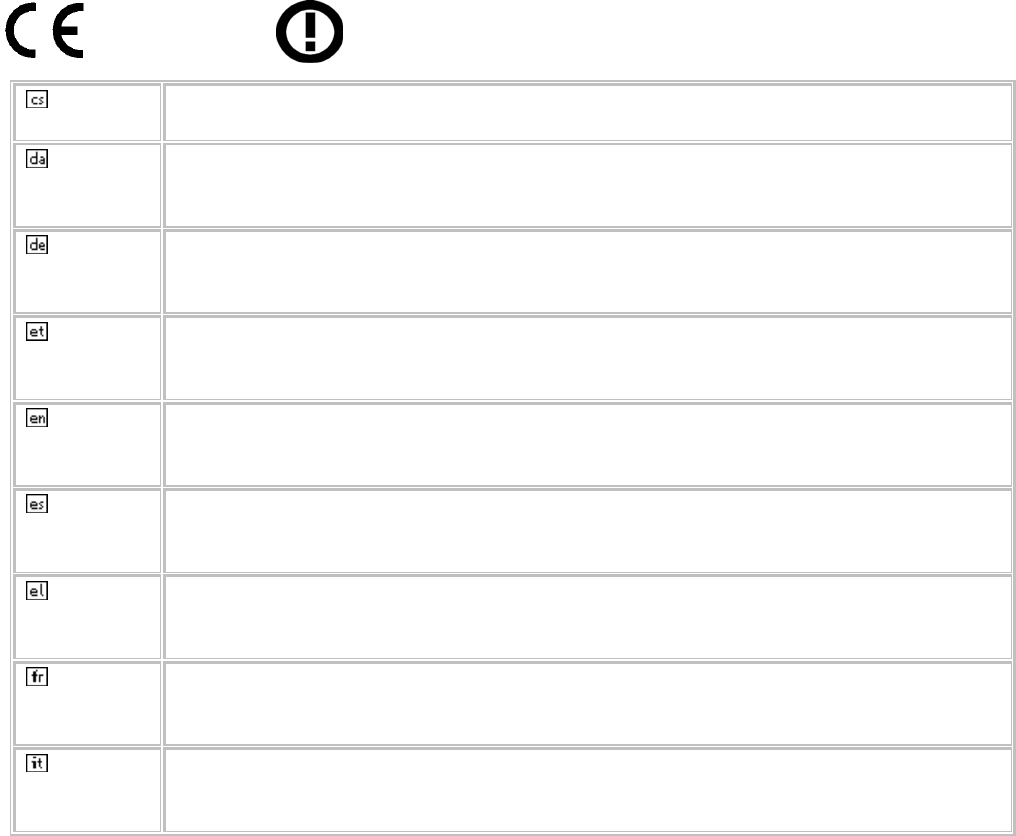
2
- EN 301 489-1 V1.8.1: (2008-04)
- Electromagnetic compatibility and Radio Spectrum Matters (ERM); ElectroMagnetic Compatibility (EMC)
standard for radio equipment and services; Part 1: Common technical requirements
- EN 301 489-17 V1.3.2 (2008-04)
- Electromagnetic compatibility and Radio spectrum Matters (ERM); ElectroMagnetic Compatibility (EMC)
standard for radio equipment; Part 17: Specific conditions for 2,4 GHz wideband transmission systems, 5
GHz high performance RLAN equipment and 5,8 GHz Broadband Data Transmitting Systems
-
This device is a 2.4 GHz wideband transmission system (transceiver), intended for use in all EU member
states and EFTA countries, except in France and Italy where restrictive use applies.
In Italy the end-user should apply for a license at the national spectrum authorities in order to obtain
authorization to use the device for setting up outdoor radio links and/or for supplying public access to
telecommunications and/or network services.
This device may not be used for setting up outdoor radio links in France and in some areas the RF output
power may be limited to 10 mW EIRP in the frequency range of 2454 – 2483.5 MHz. For detailed
information the end-user should contact the national spectrum authority in France.
0560
Česky
[Czech]
[Jméno výrobce] tímto prohlašuje, že tento [typ zařízení] je ve shodě se
základními požadavky a dalšími příslušnými ustanoveními směrnice 1999/5/ES.
Dansk
[Danish]
Undertegnede [fabrikantens navn] erklærer herved, at følgende udstyr [udstyrets
typebetegnelse] overholder de væsentlige krav og øvrige relevante krav i
direktiv 1999/5/EF.
Deutsch
[German]
Hiermit erklärt [Name des Herstellers], dass sich das Gerät [Gerätetyp] in
Übereinstimmung mit den grundlegenden Anforderungen und den übrigen
einschlägigen Bestimmungen der Richtlinie 1999/5/EG befindet.
Eesti
[Estonian]
Käesolevaga kinnitab [tootja nimi = name of manufacturer] seadme [seadme
tüüp = type of equipment] vastavust direktiivi 1999/5/EÜ põhinõuetele ja
nimetatud direktiivist tulenevatele teistele asjakohastele sätetele.
English Hereby, [name of manufacturer], declares that this [type of equipment] is in
compliance with the essential requirements and other relevant provisions of
Directive 1999/5/EC.
Español
[Spanish]
Por medio de la presente [nombre del fabricante] declara que el [clase de
equipo] cumple con los requisitos esenciales y cualesquiera otras disposiciones
aplicables o exigibles de la Directiva 1999/5/CE.
Ελληνική
[Greek]
ΜΕ ΤΗΝ ΠΑΡΟΥΣΑ [name of manufacturer] ΔΗΛΩΝΕΙ ΟΤΙ [type of equipment]
ΣΥΜΜΟΡΦΩΝΕΤΑΙ ΠΡΟΣ ΤΙΣ ΟΥΣΙΩΔΕΙΣ ΑΠΑΙΤΗΣΕΙΣ ΚΑΙ ΤΙΣ ΛΟΙΠΕΣ
ΣΧΕΤΙΚΕΣ ΔΙΑΤΑΞΕΙΣ ΤΗΣ ΟΔΗΓΙΑΣ 1999/5/ΕΚ.
Français
[French]
Par la présente [nom du fabricant] déclare que l'appareil [type d'appareil] est
conforme aux exigences essentielles et aux autres dispositions pertinentes de
la directive 1999/5/CE.
Italiano
[Italian]
Con la presente [nome del costruttore] dichiara che questo [tipo di apparecchio]
è conforme ai requisiti essenziali ed alle altre disposizioni pertinenti stabilite
dalla direttiva 1999/5/CE.
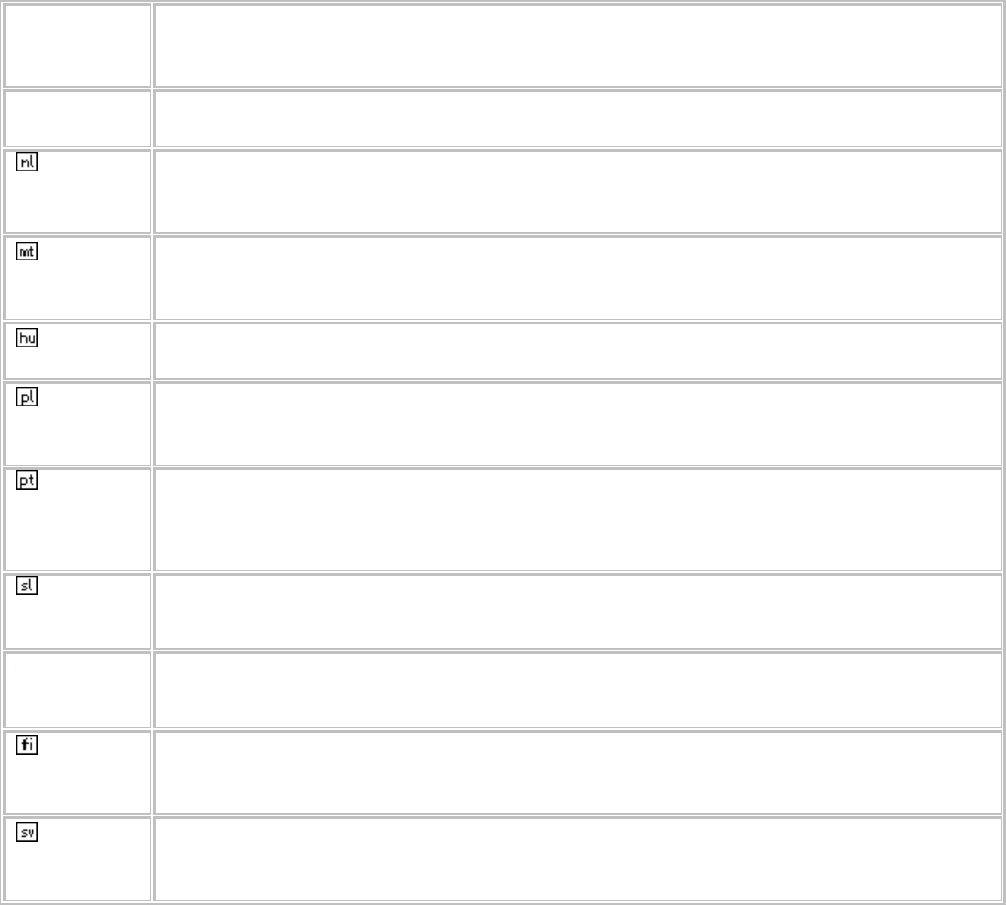
3
Latviski
[Latvian]
Ar šo [name of manufacturer / izgatavotāja nosaukums] deklarē, ka [type of
equipment / iekārtas tips] atbilst Direktīvas 1999/5/EK būtiskajām prasībām un
citiem ar to saistītajiem noteikumiem.
Lietuvių
[Lithuanian]
Šiuo [manufacturer name] deklaruoja, kad šis [equipment type] atitinka esminius
reikalavimus ir kitas 1999/5/EB Direktyvos nuostatas.
Nederlands
[Dutch]
Hierbij verklaart [naam van de fabrikant] dat het toestel [type van toestel] in
overeenstemming is met de essentiële eisen en de andere relevante bepalingen
van richtlijn 1999/5/EG.
Malti
[Maltese]
Hawnhekk, [isem tal-manifattur], jiddikjara li dan [il-mudel tal-prodott]
jikkonforma mal-ħtiġijiet essenzjali u ma provvedimenti oħrajn relevanti li hemm
fid-Dirrettiva 1999/5/EC.
Magyar
[Hungarian]
Alulírott, [gyártó neve] nyilatkozom, hogy a [... típus] megfelel a vonatkozó
alapvetõ követelményeknek és az 1999/5/EC irányelv egyéb elõírásainak.
Polski
[Polish]
Niniejszym [nazwa producenta] oświadcza, że [nazwa wyrobu] jest zgodny z
zasadniczymi wymogami oraz pozostałymi stosownymi postanowieniami
Dyrektywy 1999/5/EC.
Português
[Portuguese
]
[Nome do fabricante] declara que este [tipo de equipamento] está conforme
com os requisitos essenciais e outras disposições da Directiva 1999/5/CE.
Slovensko
[Slovenian]
[Ime proizvajalca] izjavlja, da je ta [tip opreme] v skladu z bistvenimi zahtevami
in ostalimi relevantnimi določili direktive 1999/5/ES.
Slovensky
[Slovak]
[Meno výrobcu] týmto vyhlasuje, že [typ zariadenia] spĺňa základné požiadavky
a všetky príslušné ustanovenia Smernice 1999/5/ES.
Suomi
[Finnish]
[Valmistaja = manufacturer] vakuuttaa täten että [type of equipment = laitteen
tyyppimerkintä] tyyppinen laite on direktiivin 1999/5/EY oleellisten vaatimusten
ja sitä koskevien direktiivin muiden ehtojen mukainen.
Svenska
[Swedish]
Härmed intygar [företag] att denna [utrustningstyp] står I överensstämmelse
med de väsentliga egenskapskrav och övriga relevanta bestämmelser som
framgår av direktiv 1999/5/EG.
Copyright
This publication, including all photographs, illustrations and software, is protected under international
copyright laws, with all rights reserved. Neither this manual, nor any of the material contained herein, may
be reproduced without written consent of the author.
Copyright 2006
Trademark recognition
All product names used in this manual are the properties of their respective owners and are acknowledged.
4
TableofContents
1. GettingStartedwiththeTEW‐691GR‐‐‐‐‐‐‐‐‐‐‐‐‐‐‐‐‐‐‐‐‐‐‐‐‐‐‐‐‐‐‐‐‐‐‐‐‐‐‐‐‐‐‐‐‐‐6
1.1. PackageContents‐‐‐‐‐‐‐‐‐‐‐‐‐‐‐‐‐‐‐‐‐‐‐‐‐‐‐‐‐‐‐‐‐‐‐‐‐‐‐‐‐‐‐‐‐‐‐‐‐‐‐‐‐‐‐‐‐‐‐‐‐‐‐‐‐6
1.2. MinimumSystemRequirements‐‐‐‐‐‐‐‐‐‐‐‐‐‐‐‐‐‐‐‐‐‐‐‐‐‐‐‐‐‐‐‐‐‐‐‐‐‐‐‐‐‐‐‐‐‐6
2. WirelessLANNetworking‐‐‐‐‐‐‐‐‐‐‐‐‐‐‐‐‐‐‐‐‐‐‐‐‐‐‐‐‐‐‐‐‐‐‐‐‐‐‐‐‐‐‐‐‐‐‐‐‐‐‐‐‐‐‐‐‐‐‐‐‐7
2.1. Introduction‐‐‐‐‐‐‐‐‐‐‐‐‐‐‐‐‐‐‐‐‐‐‐‐‐‐‐‐‐‐‐‐‐‐‐‐‐‐‐‐‐‐‐‐‐‐‐‐‐‐‐‐‐‐‐‐‐‐‐‐‐‐‐‐‐‐‐‐‐‐‐‐‐7
2.2. Features‐‐‐‐‐‐‐‐‐‐‐‐‐‐‐‐‐‐‐‐‐‐‐‐‐‐‐‐‐‐‐‐‐‐‐‐‐‐‐‐‐‐‐‐‐‐‐‐‐‐‐‐‐‐‐‐‐‐‐‐‐‐‐‐‐‐‐‐‐‐‐‐‐‐‐‐‐‐7
3. HardwareOverview‐‐‐‐‐‐‐‐‐‐‐‐‐‐‐‐‐‐‐‐‐‐‐‐‐‐‐‐‐‐‐‐‐‐‐‐‐‐‐‐‐‐‐‐‐‐‐‐‐‐‐‐‐‐‐‐‐‐‐‐‐‐‐‐‐‐‐‐‐9
3.1. LEDIndications‐‐‐‐‐‐‐‐‐‐‐‐‐‐‐‐‐‐‐‐‐‐‐‐‐‐‐‐‐‐‐‐‐‐‐‐‐‐‐‐‐‐‐‐‐‐‐‐‐‐‐‐‐‐‐‐‐‐‐‐‐‐‐‐‐‐‐‐‐9
3.2. RearPanel‐‐‐‐‐‐‐‐‐‐‐‐‐‐‐‐‐‐‐‐‐‐‐‐‐‐‐‐‐‐‐‐‐‐‐‐‐‐‐‐‐‐‐‐‐‐‐‐‐‐‐‐‐‐‐‐‐‐‐‐‐‐‐‐‐‐‐‐‐‐‐‐‐‐‐9
3.3. InstallationConsiderations‐‐‐‐‐‐‐‐‐‐‐‐‐‐‐‐‐‐‐‐‐‐‐‐‐‐‐‐‐‐‐‐‐‐‐‐‐‐‐‐‐‐‐‐‐‐‐‐‐‐‐‐‐‐10
3.4. GettingStarted‐‐‐‐‐‐‐‐‐‐‐‐‐‐‐‐‐‐‐‐‐‐‐‐‐‐‐‐‐‐‐‐‐‐‐‐‐‐‐‐‐‐‐‐‐‐‐‐‐‐‐‐‐‐‐‐‐‐‐‐‐‐‐‐‐‐‐‐‐10
4. UsingtheConfigurationMenu‐‐‐‐‐‐‐‐‐‐‐‐‐‐‐‐‐‐‐‐‐‐‐‐‐‐‐‐‐‐‐‐‐‐‐‐‐‐‐‐‐‐‐‐‐‐‐‐‐‐‐‐‐‐11
4.1. Network‐‐‐‐‐‐‐‐‐‐‐‐‐‐‐‐‐‐‐‐‐‐‐‐‐‐‐‐‐‐‐‐‐‐‐‐‐‐‐‐‐‐‐‐‐‐‐‐‐‐‐‐‐‐‐‐‐‐‐‐‐‐‐‐‐12
4.1.1 Network:WANSetting‐‐‐‐‐‐‐‐‐‐‐‐‐‐‐‐‐‐‐‐‐‐‐‐‐‐‐‐‐‐‐‐‐‐‐‐‐‐‐‐‐‐‐‐‐‐‐‐‐‐‐12
4.1.2 Network:LANSetting‐‐‐‐‐‐‐‐‐‐‐‐‐‐‐‐‐‐‐‐‐‐‐‐‐‐‐‐‐‐‐‐‐‐‐‐‐‐‐‐‐‐‐‐‐‐‐‐‐‐‐‐15
4.1.3 Network:QoS‐‐‐‐‐‐‐‐‐‐‐‐‐‐‐‐‐‐‐‐‐‐‐‐‐‐‐‐‐‐‐‐‐‐‐‐‐‐‐‐‐‐‐‐‐‐‐‐‐‐‐‐‐‐‐‐‐‐‐‐‐‐‐‐18
4.1.4 Network:DHCPClientList‐‐‐‐‐‐‐‐‐‐‐‐‐‐‐‐‐‐‐‐‐‐‐‐‐‐‐‐‐‐‐‐‐‐‐‐‐‐‐‐‐‐‐‐‐‐‐19
4.2. Wireless‐‐‐‐‐‐‐‐‐‐‐‐‐‐‐‐‐‐‐‐‐‐‐‐‐‐‐‐‐‐‐‐‐‐‐‐‐‐‐‐‐‐‐‐‐‐‐‐‐‐‐‐‐‐‐‐‐‐‐‐‐‐‐‐‐‐20
4.2.1 Wireless:Basic‐‐‐‐‐‐‐‐‐‐‐‐‐‐‐‐‐‐‐‐‐‐‐‐‐‐‐‐‐‐‐‐‐‐‐‐‐‐‐‐‐‐‐‐‐‐‐‐‐‐‐‐‐‐‐‐‐‐‐‐‐20
4.2.2 Wireless:Advanced‐‐‐‐‐‐‐‐‐‐‐‐‐‐‐‐‐‐‐‐‐‐‐‐‐‐‐‐‐‐‐‐‐‐‐‐‐‐‐‐‐‐‐‐‐‐‐‐‐‐‐‐‐‐‐23
4.2.3 Wireless:Security‐‐‐‐‐‐‐‐‐‐‐‐‐‐‐‐‐‐‐‐‐‐‐‐‐‐‐‐‐‐‐‐‐‐‐‐‐‐‐‐‐‐‐‐‐‐‐‐‐‐‐‐‐‐‐‐‐‐25
4.2.4 Wireless:WPS‐‐‐‐‐‐‐‐‐‐‐‐‐‐‐‐‐‐‐‐‐‐‐‐‐‐‐‐‐‐‐‐‐‐‐‐‐‐‐‐‐‐‐‐‐‐‐‐‐‐‐‐‐‐‐‐‐‐‐‐‐‐28
4.2.5 Wireless:StationList‐‐‐‐‐‐‐‐‐‐‐‐‐‐‐‐‐‐‐‐‐‐‐‐‐‐‐‐‐‐‐‐‐‐‐‐‐‐‐‐‐‐‐‐‐‐‐‐‐‐‐‐‐30
4.3. Advanced‐‐‐‐‐‐‐‐‐‐‐‐‐‐‐‐‐‐‐‐‐‐‐‐‐‐‐‐‐‐‐‐‐‐‐‐‐‐‐‐‐‐‐‐‐‐‐‐‐‐‐‐‐‐‐‐‐‐‐‐‐‐‐‐31
4.3.1 Advanced:DMZ‐‐‐‐‐‐‐‐‐‐‐‐‐‐‐‐‐‐‐‐‐‐‐‐‐‐‐‐‐‐‐‐‐‐‐‐‐‐‐‐‐‐‐‐‐‐‐‐‐‐‐‐‐‐‐‐‐‐31
4.3.2 Advanced:VirtualServer‐‐‐‐‐‐‐‐‐‐‐‐‐‐‐‐‐‐‐‐‐‐‐‐‐‐‐‐‐‐‐‐‐‐‐‐‐‐‐‐‐‐‐‐‐‐‐33
5
4.3.3 Advanced:Routing‐‐‐‐‐‐‐‐‐‐‐‐‐‐‐‐‐‐‐‐‐‐‐‐‐‐‐‐‐‐‐‐‐‐‐‐‐‐‐‐‐‐‐‐‐‐‐‐‐‐‐‐‐‐‐35
4.3.4 Advanced:AccessControl‐‐‐‐‐‐‐‐‐‐‐‐‐‐‐‐‐‐‐‐‐‐‐‐‐‐‐‐‐‐‐‐‐‐‐‐‐‐‐‐‐‐‐‐‐37
4.3.5 Advanced:SpecialApplications‐‐‐‐‐‐‐‐‐‐‐‐‐‐‐‐‐‐‐‐‐‐‐‐‐‐‐‐‐‐‐‐‐‐‐‐‐‐38
4.3.6 Advanced:Gaming‐‐‐‐‐‐‐‐‐‐‐‐‐‐‐‐‐‐‐‐‐‐‐‐‐‐‐‐‐‐‐‐‐‐‐‐‐‐‐‐‐‐‐‐‐‐‐‐‐‐‐‐‐‐40
4.3.7 Advanced:InboundFilter‐‐‐‐‐‐‐‐‐‐‐‐‐‐‐‐‐‐‐‐‐‐‐‐‐‐‐‐‐‐‐‐‐‐‐‐‐‐‐‐‐‐‐‐‐‐42
4.3.8 Advanced:Schedule‐‐‐‐‐‐‐‐‐‐‐‐‐‐‐‐‐‐‐‐‐‐‐‐‐‐‐‐‐‐‐‐‐‐‐‐‐‐‐‐‐‐‐‐‐‐‐‐‐‐‐‐‐43
4.3.9 Advanced:AdvancedNetwork‐‐‐‐‐‐‐‐‐‐‐‐‐‐‐‐‐‐‐‐‐‐‐‐‐‐‐‐‐‐‐‐‐‐‐‐‐‐‐‐44
4.4. Administrator‐‐‐‐‐‐‐‐‐‐‐‐‐‐‐‐‐‐‐‐‐‐‐‐‐‐‐‐‐‐‐‐‐‐‐‐‐‐‐‐‐‐‐‐‐‐‐‐‐‐‐‐‐‐‐‐‐45
4.4.1 Administrator:Management‐‐‐‐‐‐‐‐‐‐‐‐‐‐‐‐‐‐‐‐‐‐‐‐‐‐‐‐‐‐‐‐‐‐‐‐‐‐‐‐45
4.4.2 Administrator:UploadFirmware‐‐‐‐‐‐‐‐‐‐‐‐‐‐‐‐‐‐‐‐‐‐‐‐‐‐‐‐‐‐‐‐‐‐‐47
4.4.3 Administrator:SettingManagement‐‐‐‐‐‐‐‐‐‐‐‐‐‐‐‐‐‐‐‐‐‐‐‐‐‐‐‐‐‐48
4.4.4 Administrator:Time‐‐‐‐‐‐‐‐‐‐‐‐‐‐‐‐‐‐‐‐‐‐‐‐‐‐‐‐‐‐‐‐‐‐‐‐‐‐‐‐‐‐‐‐‐‐‐‐‐‐‐49
4.4.5 Administrator:Status‐‐‐‐‐‐‐‐‐‐‐‐‐‐‐‐‐‐‐‐‐‐‐‐‐‐‐‐‐‐‐‐‐‐‐‐‐‐‐‐‐‐‐‐‐‐‐‐‐‐50
4.5 Help‐‐‐‐‐‐‐‐‐‐‐‐‐‐‐‐‐‐‐‐‐‐‐‐‐‐‐‐‐‐‐‐‐‐‐‐‐‐‐‐‐‐‐‐‐‐‐‐‐‐‐‐‐‐‐‐‐‐‐‐‐‐‐‐‐‐‐‐‐‐51
6
1. Getting Started with the TEW-691GR
Congratulations on purchasing the TEW-691GR! This manual provides information for setting up and
configuring the TEW-691GR. This manual is intended for both home users and professionals.
1.1 Package Contents
z TEW-691GR 2.4GHz 450Mbps Wireless N Gigabit Router
z CD-ROM (User’s Guide)
z Multi-Language Quick Installation Guide
z CAT-5 Ethernet Cable
z Power Adapter (12V, 1A)
Using a power supply with a different voltage than the one included with your product will cause damage
and void the warranty for this product.
1.2 Minimum System Requirements
z Ethernet-Based Cable or DSL Modem
z Computers with Windows, Macintosh, or Linux-based operating systems with an installed
Ethernet adapter and CD-ROM Drive
z Internet Explorer Version 6.0 or Netscape Navigator Version 7.0 and Above

7
2. Wireless LAN Networking
This section provides background information on wireless LAN networking technology. Consult the
Glossary for definitions of the terminology used in this section.
THE INFORMATION IN THIS SECTION IS FOR YOUR REFERENCE. CHANGING NETWORK SETTINGS AND PARTICULARLY
SECURITY SETTTINGS SHOULD ONLY BE DONE BY AN AUTHORIZED ADMINISTRATOR.
Transmission Rate (Transfer Rate)
The TEW-691GR provides various transmission (data) rate options for you to select. In most networking
scenarios, the factory default Best (automatic) setting proves the most efficient. This setting allows your
TEW-691GR to operate at the maximum transmission (data) rate. When the communication quality drops
below a certain level, the TEW-691GR automatically switches to a lower transmission (data) rate.
Transmission at lower data speeds is usually more reliable. However, when the communication quality
improves again, the TEW-691GR gradually increases the transmission (data) rate again until it reaches the
highest available transmission rate.
2.1 Introduction
The TEW-691GR 2.4GHz 450Mbps Wireless N Gigabit Router is an high-performance, wireless router that
supports high-speed wireless networking at home, at work or in public places.
Unlike most routers, the TEW-691GR provides data transfers at up to 450Mbps when using 11n connection.
This router is also back compatible with 802.11g or 11b devices. This means that you do not need to
change your entire network to maintain connectivity. You may sacrifice some of 11n’s speed when you mix
11n and 11b/g devices, but you will not lose the ability to communicate when you incorporate the 11n
standard into your 11b/g network. You may choose to slowly change your network by gradually replacing
the 11b/g devices with 11n devices.
2.2 Features
Supports draft IEEE 802.11n & 11b/g 2.4GHz wireless Local Area Network (WLAN) application
2.412 to 2.472GHz frequency band operation, the operation frequency range for US model is
limited to channel 1 to 11
Compliant with IEEE 802.3, 802.3u & 802.3ab standards
Support OFDM and CCK modulation
High-Speed up to 450Mbps Data Rate using IEEE 802.11n 3x3 connection
Supports Cable/DSL Modems with Dynamic IP, Static IP, PPPoE, PPTP, L2TP Connection Types
8
Firewall features Network Address Translation (NAT)
UPnP support and ALGs Support for RTP/RTSP, SIP, FTP, TFTP NTP, SMTP,
HTTPS, POP3, NetMeeting, Telnet, H.323, STUN
Provides Additional Security of Enable/Disable SSID, WLAN MAC address filtering Internet
Access Control (IP/Port range blocking)
Supports IPSec, L2TP and PPTP VPN Pass-Through Sessions
Easy wireless setup via PBC or PIN of Wi-Fi Protected Setup
Support 4 x 10/100/1000Mbps Auto-MDIX LAN Port and 1 x 10/100/1000Mbps Auto-MDIX WAN
Port (Internet)
Built-in 3 external antennas to support high speed performance and great coverage
Window 7 compliance
Support Video Turbine to get better performance (Phase II)
Support Priority queue for stream control packets (Phase II)
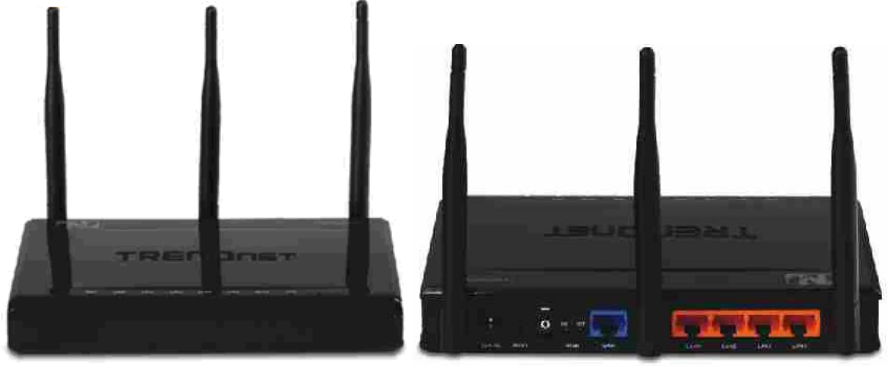
9
3. Hardware Overview
3.1 LED Indications: (from left to right)
WPS
WLAN
Reserve
LAN1
LAN2
LAN3
LAN4
WAN
PWR
3.2 Rear panel: (from left to right)
DC-IN
RESET
Power switch
Wi-Fi on/off switch
WAN
LAN1
LAN2
LAN3
LAN4
10
3.3 Installation Considerations
The TEW-691GR 2.4GHz Wireless N Gigabit Router lets you access your network, using a wireless
connection, from virtually anywhere within its operating range. Keep in mind, however, that the number,
thickness and location of walls, ceilings, or other objects that the wireless signals must pass through, may
limit the range. Typical ranges vary depending on the types of materials and background RF (radio
frequency) noise in your home or business. The key to maximizing wireless range is to follow these basic
guidelines:
1 Keep the number of walls and ceilings between the TEW-691GR and other network devices to a
minimum - each wall or ceiling can reduce your wireless product’s range from 3-90 feet (1-30 meters.)
Position your devices so that the number of walls or ceilings is minimized.
2 Be aware of the direct line between network devices. A wall that is 1.5 feet thick (.5 meters), at a
45-degree angle appears to be almost 3 feet (1 meter) thick. At a 2-degree angle it looks over 42
feet (14 meters) thick! Position devices so that the signal will travel straight through a wall or ceiling
(instead of at an angle) for better reception.
3 Building Materials can impede the wireless signal - a solid metal door or aluminum studs may have a
negative effect on range. Try to position wireless devices and computers with wireless adapters so
that the signal passes through drywall or open doorways and not other materials.
4 Keep your product away (at least 3-6 feet or 1-2 meters) from electrical devices or appliances that
generate extreme RF noise.
3.4 Getting Started
For a typical wireless setup at home, please do the following:
1. You will need broadband Internet access (a Cable or DSL-subscriber line into your home or
office)
2. Consult with your Cable or DSL provider for proper installation of the modem.
3. Connect the Cable or DSL modem to the TEW-691GR Wireless Broadband Router (WAN
port).
4. Ethernet LAN ports of the TEW-691GR are Auto MDI/MDIX and will work with both
Straight-Through and Cross-Over cable.
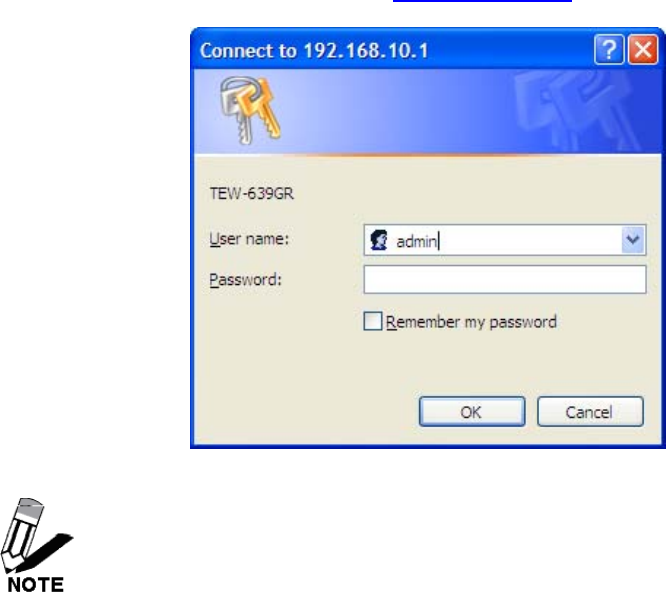
11
4. Using the Configuration Menu
Whenever you want to configure your TEW-691GR, you can access the Configuration Menu through
your PC by opening the Web-browser and typing in the IP Address of the TEW-691GR. The
TEW-691GR’s default IP Address is http://192.168.10.1
¾ Open the Web browser.
¾ Type in the IP Address of the Router (http://192.168.10.1 )
If you have changed the default IP Address assigned to the TEW-691GR, make sure to
enter the correct IP Address.
¾ Select admin in the User Name field.
¾ Leave the Password blank.
¾ Click Login In.
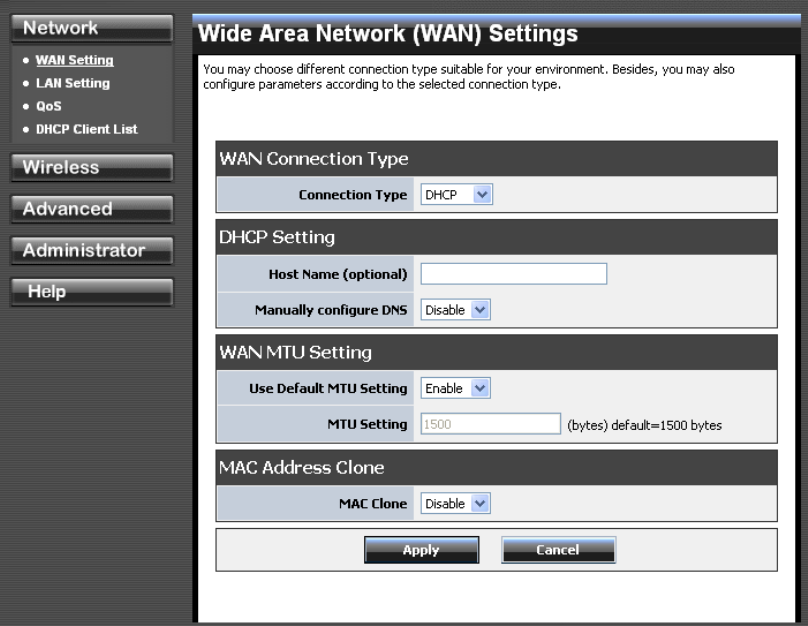
12
4.1 Network
4.1.1. Network: WAN Setting
WAN Connection Type
There are several connection types to choose from: Static IP, DHCP, PPPoE, PPTP, L2TP,
and Russia PPTP. If you are unsure of your connection method, please contact your Internet
Service Provider. Static
Used when your ISP provides you a set IP address that does not change. The IP information is
manually entered in your IP configuration settings. You must enter the IP address, Subnet
Mask, Gateway, Primary DNS Server, and Secondary DNS Server. Your ISP provides you with
all of this information.
DHCP
A method of connection where the ISP assigns your IP address when your router requests one
from the ISP's server.
Host Name: Some ISP's may check your computer's Host Name. The Host Name identifies
your system to the ISP's server.
PPPoE
Select this option if your ISP requires you to use a PPPoE (Point to Point Protocol over
Ethernet) connection. DSL providers typically use this option. This method of connection
requires you to enter a Username and Password (provided by your Internet Service Provider)
to gain access to the Internet.
Reconnect Mode: Typically PPPoE connections are not always on. The router allows you to
set the reconnection mode. The settings are:
Always on: A connection to the Internet is always maintained.
13
On demand: A connection to the Internet is made as needed.
Manual: You have to open up the Web-based management interface and click the Connect
button manually any time that you wish to connect to the Internet.
Maximum Idle Time: Time interval the machine can be idle before the PPPoE connection is
disconnected. The Maximum Idle Time value is only used for the "On demand" and "Manual"
reconnect modes.
L2TP
L2TP (Layer Two Tunneling Protocol) uses a virtual private network to connect to your ISP.
This method of connection requires you to enter a Username and Password (provided by your
Internet Service Provider) to gain access to the Internet.
L2TP Server IP Address: The ISP provides this parameter, if necessary. The value may be
the same as the Gateway IP Address.
Reconnect Mode: Typically PPPoE connections are not always on. The router allows you to
set the reconnection mode. The settings are:
Always on: A connection to the Internet is always maintained.
On demand: A connection to the Internet is made as needed.
Manual: You have to open up the Web-based management interface and click the Connect
button manually any time that you wish to connect to the Internet.
Maximum Idle Time: Time interval the machine can be idle before the PPPoE connection is
disconnected. The Maximum Idle Time value is only used for the "On demand" and "Manual"
reconnect modes.
WAN Interface IP Type
Static: If your ISP has assigned a fixed IP address, select this option. The ISP provides the
values for the following fields for WAN Interface IP Setting: IP Address, Subnet Mask ,
Default Gateway.
Dynamic: If the ISP's servers assign the router's IP addressing upon establishing a connection,
select this option.
PPTP
PPTP (Point to Point Tunneling Protocol) uses a virtual private network to connect to your ISP.
This method of connection is primarily used in Europe. This method of connection requires you
to enter a Username and Password (provided by your Internet Service Provider) to gain
access to the Internet.
PPTP Server IP Address: The ISP provides this parameter, if necessary. The value may be
the same as the Gateway IP Address.
Reconnect Mode: Typically PPPoE connections are not always on. The router allows you to
set the reconnection mode. The settings are:
Always on: A connection to the Internet is always maintained.
On demand: A connection to the Internet is made as needed.
Manual: You have to open up the Web-based management interface and click the Connect
button manually any time that you wish to connect to the Internet.
Maximum Idle Time: Time interval the machine can be idle before the PPPoE connection is
disconnected. The Maximum Idle Time value is only used for the "On demand" and "Manual"
reconnect modes.
WAN Interface IP Type
Static: If your ISP has assigned a fixed IP address, select this option. The ISP provides the
values for the following fields for WAN Interface IP Setting: IP Address, Subnet Mask ,
Default Gateway, and optional for DNS Server
Dynamic: If the ISP's servers assign the router's IP addressing upon establishing a connection,
select this option.
Russia PPTP
The Russia PPTP can configure IP address on the WAN interface and establish PPTP to get
IP address, subnet mask, default gateway and DNS for ANOTHER logical IP interface on WAN
port. So the physical WAN port will have 2 logical IP interfaces and can communicate with
14
internal ISP’s network resources and also communicate with Internet through PPTP tunnel. It is
specified by Russia Cobrina ISP, user can configure it the same as the normal PPTP and
PPTP server IP Address can use the domain name string.
WAN MTU Setting
The Maximum Transmission Unit (MTU) is a parameter that determines the largest packet size
(in bytes) that the router will send to the WAN. If LAN devices send larger packets, the router
will break them into smaller packets. Ideally, you should set this to match the MTU of the
connection to your ISP. Typical values are 1500 bytes for an Ethernet connection and 1492
bytes for a PPPoE connection. If the router's MTU is set too high, packets will be fragmented
downstream. If the router's MTU is set too low, the router will fragment packets unnecessarily
and in extreme cases may be unable to establish some connections. In either case, network
performance can suffer. t modes.
MAC Address Clone
Each networking device has it's own unique MAC address defined by the hardware
manufacturer. Some ISP's may check your computer's MAC address. Some ISP's record the
MAC address of the network adapter in the computer or router used to initially connect to their
service. The ISP will then only grant Internet access to requests from a computer or router with
this particular MAC address. This router has a different MAC address than the computer or
router that initially connected to the ISP. If you need to change the MAC address of the
rounter's WAN-side Ethernet interface, either type in an alternate MAC address (for example,
the MAC address of the router initially connected to the ISP) or copy the MAC address of a PC.
To copy the MAC address of the computer that initially connected to the ISP, connect to the
router using that computer and click the Clone Your PC's MAC Address button. The WAN
interface will then use the MAC address of the network adapter in your computer.
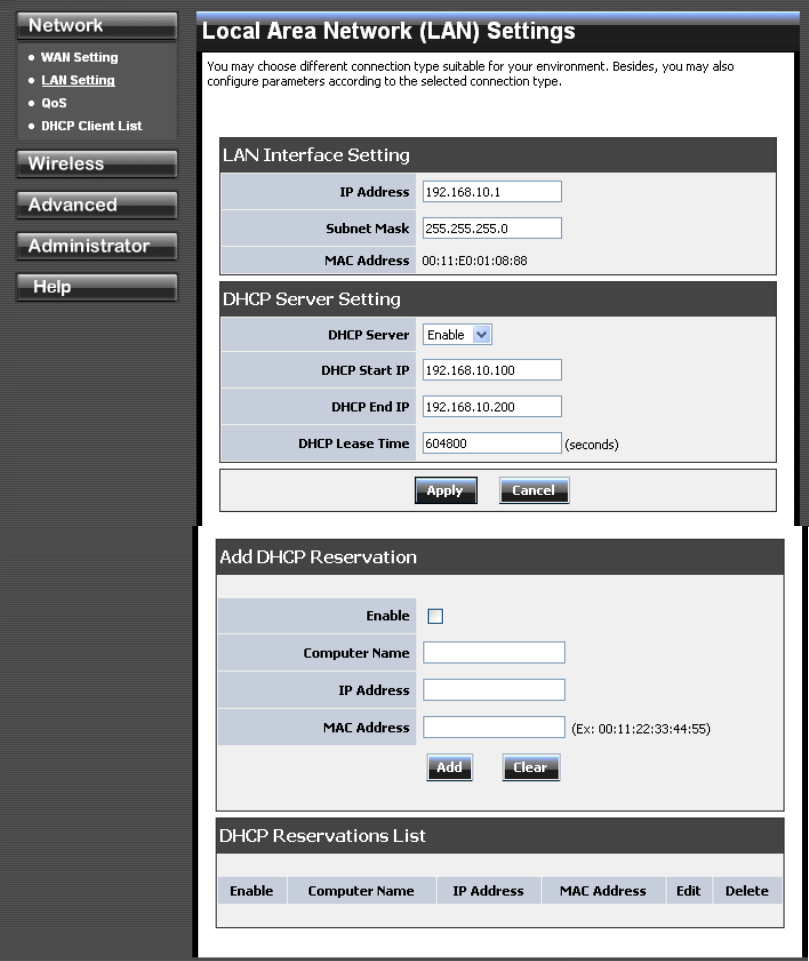
15
4.1.2. Network: LAN Setting
IP Address
The IP address of the this device on the local area network. Assign any unused IP address in
the range of IP addresses available for the LAN.
Subnet Mask
The subnet mask of the local area network.
DHCP Server Settings
16
DHCP stands for Dynamic Host Configuration Protocol. The DHCP section is where you
configure the built-in DHCP Server to assign IP addresses to the computers and other devices
on your local area network (LAN).
Enable DHCP Server
Once your router is properly configured and this option is enabled, the DHCP Server will
manage the IP addresses and other network configuration information for computers and other
devices connected to your Local Area Network. There is no need for you to do this yourself.
The computers (and other devices) connected to your LAN also need to have their TCP/IP
configuration set to "DHCP" or "Obtain an IP address automatically". When you set Enable
DHCP Server, the following options are displayed.
DHCP IP Address Range
These two IP values (Start and End) define a range of IP addresses that the DHCP Server
uses when assigning addresses to computers and devices on your Local Area Network. Any
addresses that are outside of this range are not managed by the DHCP Server; these could,
therefore, be used for manually configured devices or devices that cannot use DHCP to obtain
network address details automatically.
It is possible for a computer or device that is manually configured to have an address that does
reside within this range. In this case the address should be reserved, so that the DHCP Server
knows that this specific address can only be used by a specific computer or device.
Your router, by default, has a static IP address of 192.168.10.1. This means that addresses
192.168.10.2 to 192.168.10.254 can be made available for allocation by the DHCP Server.
Subnet Mask
The subnet mask of the local area network.
Gateway
The IP address of the router on the local area network. For example, 192.168.10.1.
DHCP Lease Time
The amount of time that a computer may have an IP address before it is required to renew the
lease. The lease functions just as a lease on an apartment would. The initial lease designates
the amount of time before the lease expires. If the tenant wishes to retain the address when
the lease is expired then a new lease is established. If the lease expires and the address is no
longer needed than another tenant may use the address.
Add/Edit DHCP Reservation
This option lets you reserve IP addresses, and assign the same IP address to the network
device with the specified MAC address any time it requests an IP address. This is almost the
same as when a device has a static IP address except that the device must still request an IP
address from the router. The router will provide the device the same IP address every time.
DHCP Reservations are helpful for server computers on the local network that are hosting
applications such as Web and FTP. Servers on your network should either use a static IP
address or use this option.
Computer Name
You can assign a name for each computer that is given a reserved IP address. This may help
you keep track of which computers are assigned this way. Example: Game Server.
IP Address:
The LAN address that you want to reserve.
MAC Address
To input the MAC address of your system, enter it in manually or connect to the router's
Web-Management interface from the system and click the Copy Your PC's MAC Address
button.
A MAC address is usually located on a sticker on the bottom of a network device. The MAC
address is comprised of twelve digits. Each pair of hexadecimal digits are usually separated by
dashes or colons such as 00-0D-88-11-22-33 or 00:0D:88:11:22:33. If your network device is a
17
computer and the network card is already located inside the computer, you can connect to the
router from the computer and click the Copy Your PC's MAC Address button to enter the
MAC address.
Clear
Re-initialize this area of the screen, discarding any changes you have made.
DHCP Reservations List
This shows clients that you have specified to reserve DHCP addresses. Click the Enable
checkbox at the left to directly activate or de-activate the entry. An entry can be changed by
clicking the Edit icon or can be deleted by clicking the Delete icon. When you click the Edit icon,
the item is highlighted, and the "Edit DHCP Reservation" section is activated for editing.
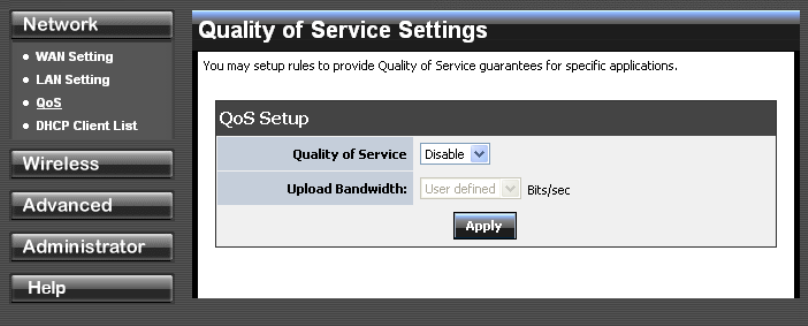
18
4.1.3. Network: QoS
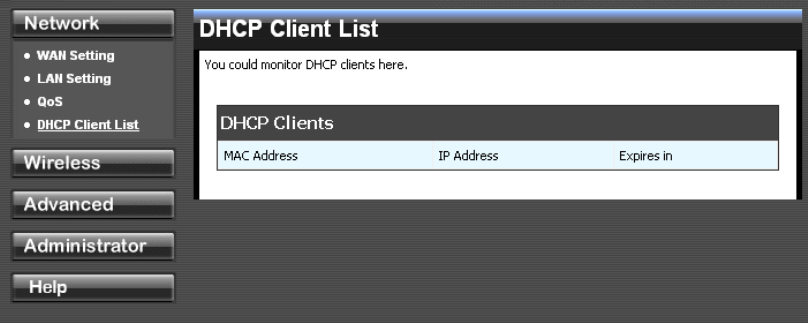
19
4.1.4. Network: DHCP Client List
In this section you can see the connected LAN devices are currently receiving an IP addresses.
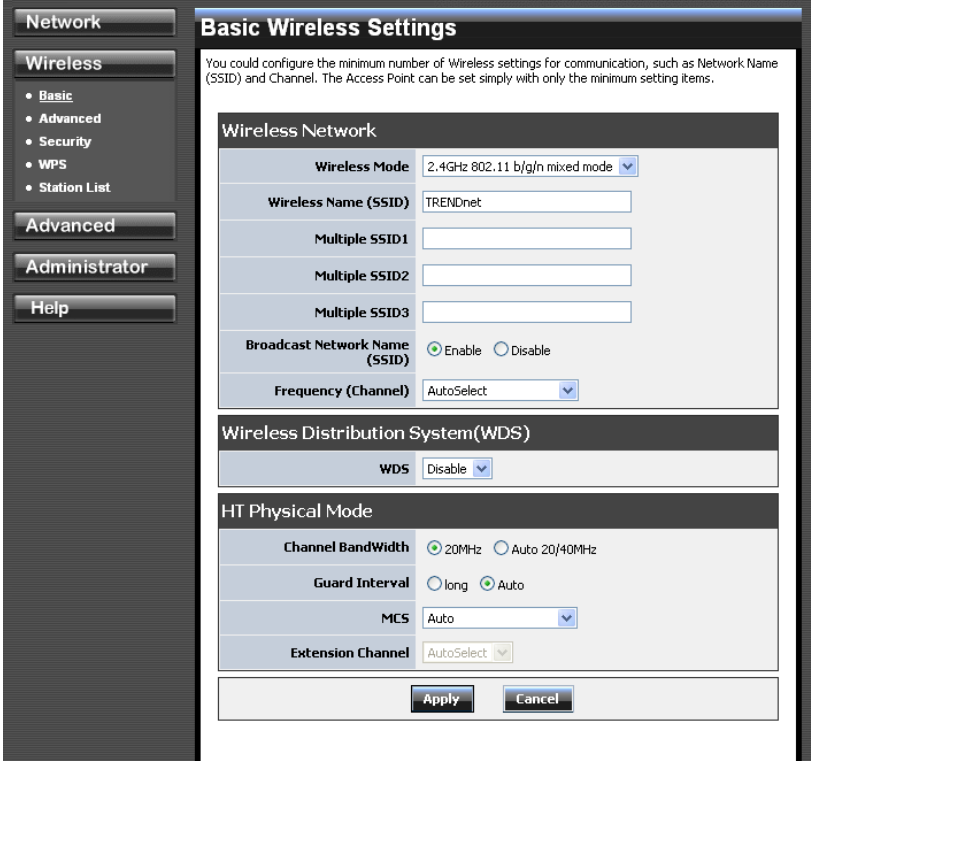
20
4.2 Wireless
4.2.1 Wireless: Basic
Radio On/Off
This indicates the wireless operating status. The wireless can be turned on or off by the slide
switch. When the radio is on, the following parameters are in effect.
Wireless Mode
If all of the wireless devices you want to connect with this router can connect in the same
transmission mode, you can improve performance slightly by choosing the appropriate wireless
mode. If you have some devices that use a different transmission mode, choose the
appropriate wireless mode. The TEW-691GR supports 2.4GHz wireless networks. There
are many different configuration options available to choose from. Use the drop down list to
select the wireless mode.
21
Note: One wireless mode can be selected can select at any one time. This means that you can
only select one of the operating frequency at a time.
Wireless Mode options
2.4GHz 802.11b/g mixed mode - This wireless mode works in the 2.4GHz frequency range
and will allow both wireless b and wireless g client to connect and access the TEW-691GR at
11Mbps for wireless b, at 54Mbps for wireless g and share access at the same time. Although
the wireless b/g operates in the 2.4GHz frequency, it will allow the use of other 2.4GHz client
devices (Wireless n/g @ 54Mbps) to connect and access at the same time.
2.4GHz 802.11 n only – This wireless mode works in the 2.4GHz frequency range and will
only allow the use of wireless n client devices to connect and access the TEW-691GR up to
450Mbps*. Although the wireless n operates in the 2.4GHz frequency, this mode will only
permit wireless n client devices to work and will exclude any other wireless mode and devices
that are not wireless n only.
2.4 GHz 802.11b/g/n mixed mode - This wireless mode works in the 2.4GHz frequency range
and will only allow the use of wireless g client devices to connect and access the TEW-691GR
at 11Mbps for wireless b, 54Mbps for wireless g and up to 450Mbps* for wireless n and share
access at the same time. Although the wireless b/g/n operates in the same 2.4GHz frequency,
it will allow the use of other 2.4GHz client devices (Wireless b/g/n) to connect and access at
the same time.
*Maximum wireless signal rates are referenced from IEEE 802.11 theoretical specifications. Actual data throughput
and coverage will vary depending on interference, network traffic, building materials and other conditions.
Wireless Network Name (SSID)
When you are browsing for available wireless networks, this is the name that will appear in the
list (unless Visibility Status is set to Invisible, see below). This name is also referred to as the
SSID. For security purposes, it is highly recommended to change from the pre-configured
network name. Add up to three additional SSIDs to create virtual wireless networks from one
wireless Router Access Point device.
Add Additional Wireless Network Name (SSID)
To add additional wireless Network Names simply add the name to the Multiple SSID field and
click on apply at the bottom of the page. When finished, go to the Security section in this Users
Guide for wireless security configuration.
Frequency (Channel)
A wireless network uses specific channels in the wireless spectrum to handle communication
between clients. Some channels in your area may have interference from other electronic
devices. Choose the clearest channel to help optimize the performance and coverage of your
wireless network.
Wireless Distribution System (WDS)
When WDS is enabled, this access point functions as a wireless repeater and is able to
wirelessly communicate with other APs via WDS links. A WDS link is bidirectional; so this AP
must know the MAC Address (creates the WDS link) of the other AP, and the other AP must
have a WDS link back to this AP. Make sure the APs are configured with same channel.
(Note that WDS security is incompatible with mixed mode, like WPAPSK+WPA2PSK mixed,
WEP AUTO and 802.1x, both feature cannot be used at the same time).
Configuring WDS with TEW-691GR
Enable the option for WDS and input the MAC Address of the wireless device that also
supports WDS in to the blank fields. You can add up to four additional devices in the spaces
provided. Click on apply at the bottom of the page, to apply your setting changes.
Enable the security seeing in security page, each WDS APs need to use same security setting.
(Note: WDS supports wireless g/n modes. The use multiple Access Point will reduces the
overall network throughput to ½ the TEW-691GR.
HT Physical Mode
In HT (High Throughput) Physical mode setting allow for control of the 802.11n wireless
environment.

22
Operating Mode
Mixed Mode
Green Field
Mixed Mode: In this mode packets are transmitted with a preamble compatible with the legacy
802.11a/g, the rest of the packet has a new format. In this mode the receiver shall be able to
decode both the Mixed Mode packets and legacy packets.
Green Field: In this mode high throughput packets are transmitted without a legacy compatible
part.
Channel BandWidth:
Set channel width of wireless radio.
20
20/40
20 Channel Width = 20 MHz
20/40 Channel Width = 20/40 MHz
Guard Interval:
Support Short/Long GI, the purpose of the guard interval is to introduce immunity to
propagation delays, echoes and reflections, to which digital data is normally very sensitive.
Long
Auto
Long Guard Interval, 800 nsec
Short Guard Interval, 400 nsec
MCS:
Fix MCS rate for HT rate.
0-15
The Modulation and Coding Scheme (MCS) is a value that determines the modulation, coding
and number of spatial channels.
802.11
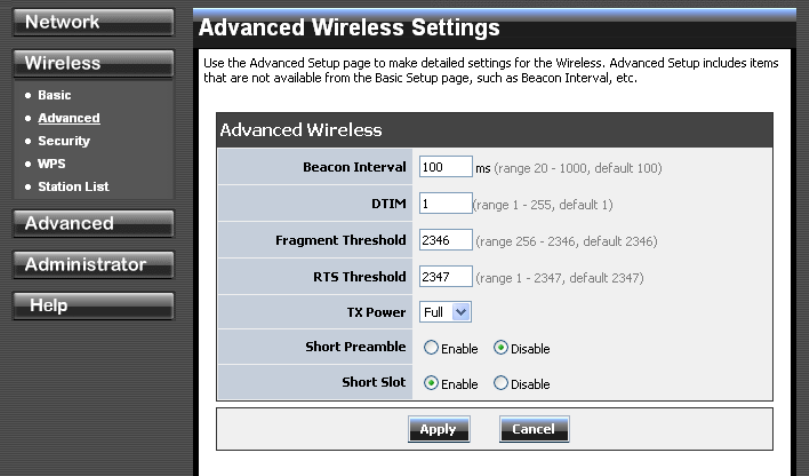
23
4.2.2 Wireless: Advanced
Beacon Interval
Beacons are packets sent by a wireless router to synchronize wireless devices. Specify a
Beacon Period value between 20 and 1000. The default value is set to 100 milliseconds.
DTIM
A DTIM is a countdown informing clients of the next window for listening to broadcast and
multicast messages. When the wireless router has buffered broadcast or multicast messages
for associated clients, it sends the next DTIM with a DTIM Interval value. Wireless clients
detect the beacons and awaken to receive the broadcast and multicast messages. The default
value is 1. Valid settings are between 1 and 255.
Fragmentation Threshold
Wireless frames can be divided into smaller units (fragments) to improve performance in the
presence of RF interference and at the limits of RF coverage. Fragmentation will occur when
frame size in bytes is greater than the Fragmentation Threshold. This setting should remain at
its default value of 2346 bytes. Setting the Fragmentation value too low may result in poor
performance.
RTS Threshold
When an excessive number of wireless packet collisions are occurring, wireless performance
can be improved by using the RTS/CTS (Request to Send/Clear to Send) handshake protocol.
The wireless transmitter will begin to send RTS frames (and wait for CTS) when data frame
size in bytes is greater than the RTS Threshold. This setting should remain at its default value
of 2346 bytes.
Short Preamble and Slot
Using a short (400ns) guard interval can increase throughput. However, it can also increase
error rate in some installations, due to increased sensitivity to radio-frequency reflections.
Select the option that works best for your installation.
TX Burst
Allows the wireless Router to deliver better throughput in the same period and environment in
order to increase speed.
Pkt_Aggregate
24
Increase efficiency by aggregating multiple packets of application data into a single
transmission frame. In this way, 802.11n networks can send multiple data packets with the
fixed overhead cost of just a single frame.
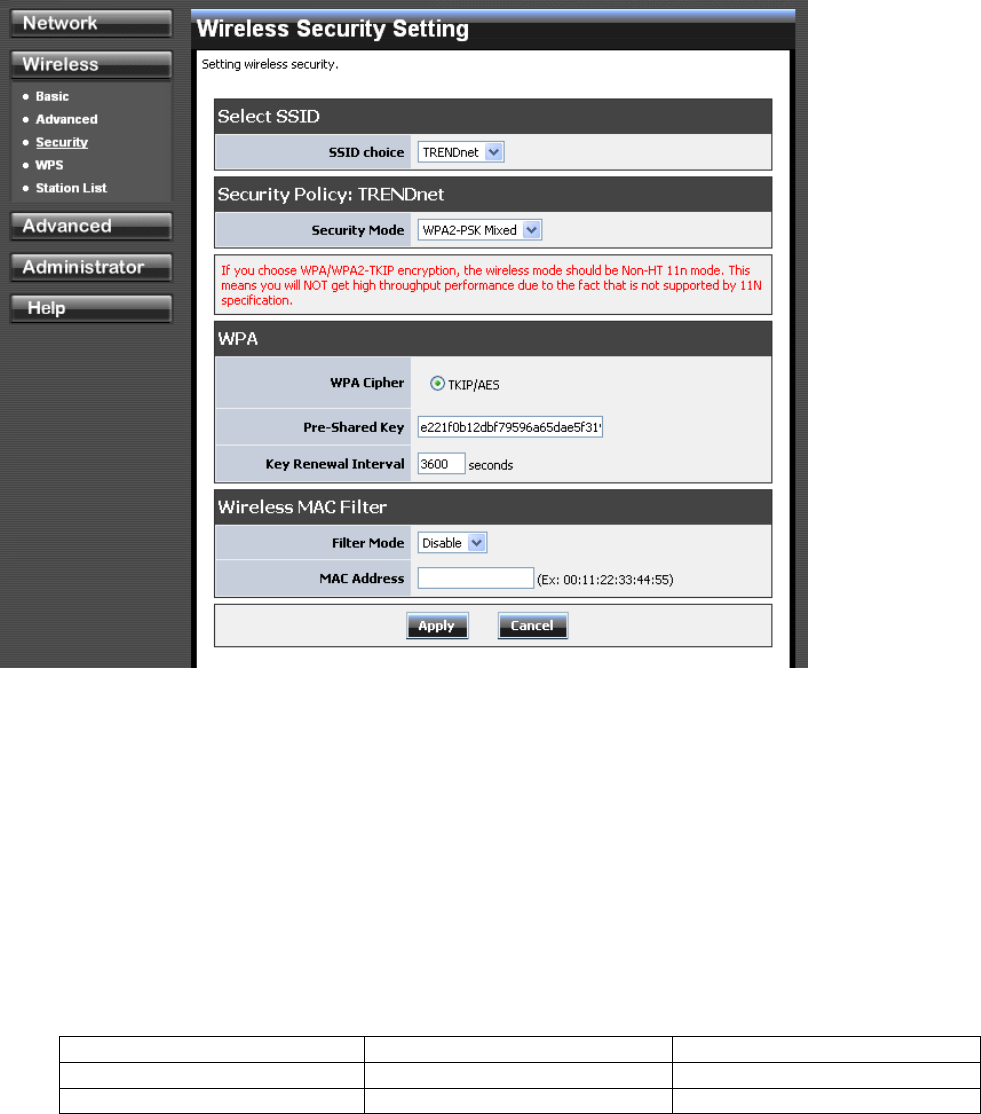
25
4.2.3 Wireless: Security
Security Mode
Unless one of these encryption modes is selected, wireless transmissions to and from your
wireless network can be easily intercepted and interpreted by unauthorized users.
WEP
A method of encrypting data for wireless communication intended to provide the same level of
privacy as a wired network. WEP is not as secure as WPA encryption. To gain access to a
WEP network, you must know the key. The key is a string of characters that you create. When
using WEP, you must determine the level of encryption. The type of encryption determines the
key length. 128-bit encryption requires a longer key than 64-bit encryption. Keys are defined by
entering in a string in HEX (hexadecimal - using characters 0-9, A-F) or ASCII (American
Standard Code for Information Interchange - alphanumeric characters) format. ASCII format is
provided so you can enter a string that is easier to remember. The ASCII string is converted to
HEX for use over the network. Four keys can be defined so that you can change keys easily. A
default key is selected for use on the network.
Key Length Hex ASCII
64-bit 10 characters 5 characters
128-bit 26 characters 13 characters
WPA-Personal and WPA-Enterprise
Both of these options select some variant of Wi-Fi Protected Access (WPA) -- security
standards published by the Wi-Fi Alliance. The WPA Mode further refines the variant that the
router should employ.
26
WPA Mode: WPA is the older standard; select this option if the clients that will be used with the
router only support the older standard. WPA2 is the newer implementation of the stronger
IEEE 802.11i security standard. With the "WPA2" option, the router tries WPA2 first, but falls
back to WPA if the client only supports WPA. With the "WPA2 Only" option, the router
associates only with clients that also support WPA2 security.
Cipher Type: The encryption algorithm used to secure the data communication. TKIP
(Temporal Key Integrity Protocol) provides per-packet key generation and is based on WEP.
AES (Advanced Encryption Standard) is a very secure block based encryption. With the "TKIP
and AES" option, the router negotiates the cipher type with the client, and uses AES when
available.
Group Key Update Interval: The amount of time before the group key used for broadcast and
multicast data is changed.
WPA-Personal
This option uses Wi-Fi Protected Access with a Pre-Shared Key (PSK).
Pre-Shared Key: The key is entered as a pass-phrase of up to 63 alphanumeric characters in
ASCII (American Standard Code for Information Interchange) format at both ends of the
wireless connection. It cannot be shorter than eight characters, although for proper security it
needs to be of ample length and should not be a commonly known phrase. This phrase is used
to generate session keys that are unique for each wireless client.
WPA-Enterprise
This option works with a RADIUS Server to authenticate wireless clients. Wireless clients
should have established the necessary credentials before attempting to authenticate to the
Server through this Gateway. Furthermore, it may be necessary to configure the RADIUS
Server to allow this Gateway to authenticate users.
Authentication Timeout: Amount of time before a client will be required to re-authenticate.
RADIUS Server IP Address: The IP address of the authentication server.
RADIUS Server Port: The port number used to connect to the authentication server.
RADIUS Server Shared Secret: A pass-phrase that must match with the authentication server.
WPA/WPA2 mixed environment
For those WPA2 stations, they will use AES for unicast. For those WPA stations, they will use
TKIP for unicast. But for multicast all WPA and WPA2 stations have to use the same key, and
that will be TKIP, because WPA station only knows about TKIP, WPA2 is new standard, so it
is defined to backward support TKIP on multicast.
Wireless MAC Filtering
Choose the type of MAC filtering needed.
Turn MAC Filtering Disable: When "Disable" is selected, MAC addresses are not used to
control network access.
Add MAC Filtering Rule
Use this section to add MAC addresses to the list below.
MAC Address
Enter the MAC address of a computer that you want to control with MAC filtering. Computers
that have obtained an IP address from the router's DHCP server will be in the DHCP Client List.
Select a device from the drop down menu.
The rule of thumb:
In mixed mode, multicast key has to be TKIP, but unicast key can be different per stations.
In WPA or WPA2 only mode, unicast and multicast key can be only AES for WPA2, and TKIP
27
for WPA. (AES means the unicast and multicast key are all AES. TKIP/AES means multicast
is TKIP. But unicast can be AES or TKIP, which depends on the peer.)
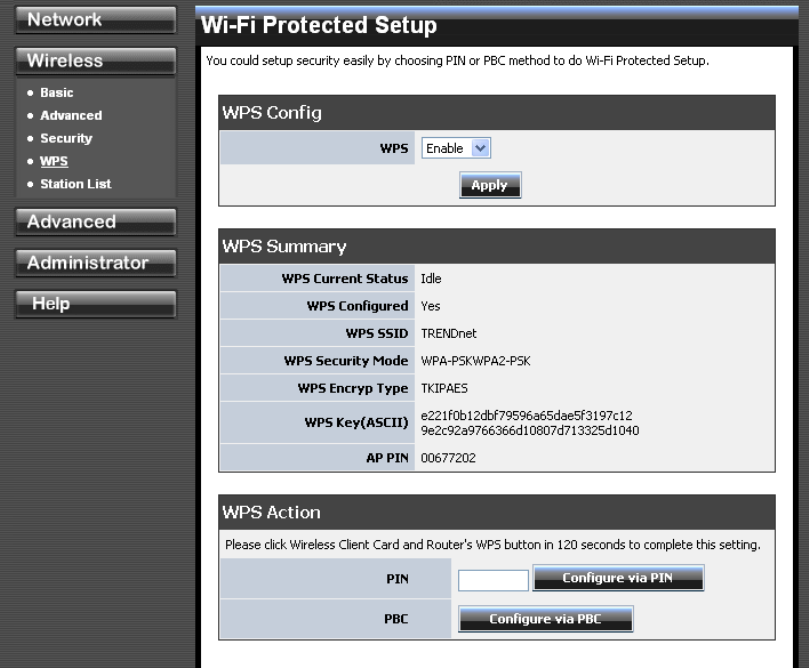
28
4.2.4 Wireless: WPS
29
Enable
Enable the WPS feature.
Lock Wireless Security Settings
Locking the wireless security settings prevents the settings from being changed by any new
external registrar using its PIN. Devices can still be added to the wireless network using WPS.
PIN Settings
A PIN is a unique number that can be used to add the router to an existing network or to create
a new network. The default PIN may be printed on the bottom of the router. For extra security,
a new PIN can be generated. You can restore the default PIN at any time. Only the
Administrator ("admin" account) can change or reset the PIN.
Current PIN
Shows the current value of the router's PIN.
Reset To WPS Default
Restore the default PIN of the router.
Generate New PIN
Create a random number that is a valid PIN. This becomes the router's PIN. You can then copy
this PIN to the user interface of the registrar.
PBC Settings
The push button method can be used to allow wireless clients to connect to the router without
entering/remember any encryption keys. The user can use the PBC method by pressing the
WPS button on the side of the router or select the PBC option under Wireless/WPS settings
page and hit Apply.
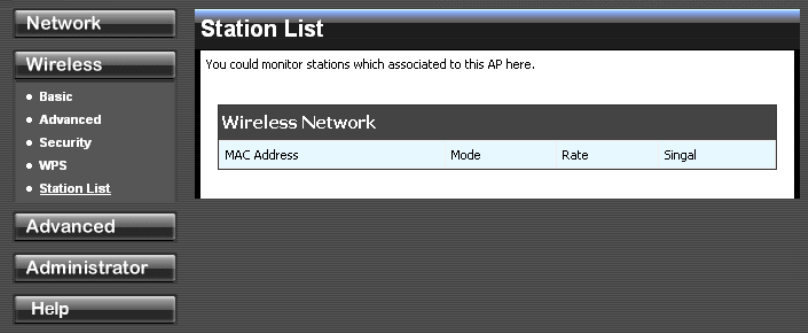
30
4.2.5 Wireless: Station List
All the wireless clients connecting to the router will be shown here, you could monitor your network
and prevent any unauthorized wireless connection easily.
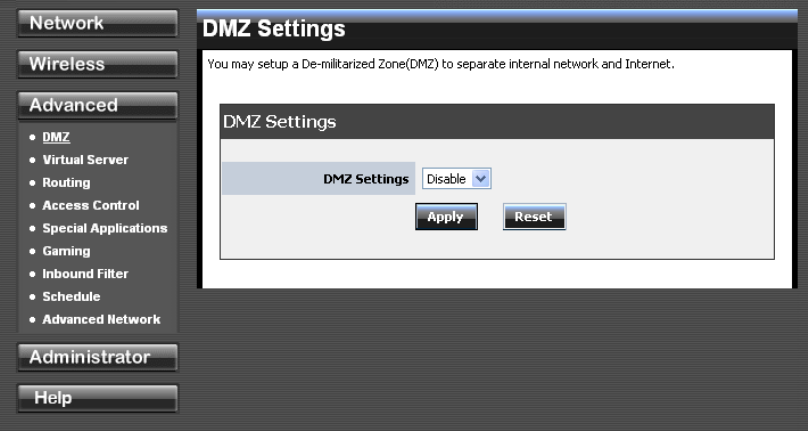
31
4.3 Advanced
4.3.1 Advanced: DMZ
DMZ Setting
DMZ means "Demilitarized Zone." If an application has trouble working from behind the router,
you can expose one computer to the Internet and run the application on that computer.
When a LAN host is configured as a DMZ host, it becomes the destination for all incoming
packets that do not match some other incoming session or rule. If any other ingress rule is in
place, that will be used instead of sending packets to the DMZ host; so, an active session,
virtual server, active port trigger, or port forwarding rule will take priority over sending a packet
to the DMZ host. (The DMZ policy resembles a default port forwarding rule that forwards every
port that is not specifically sent anywhere else.)
The router provides only limited firewall protection for the DMZ host. The router does not
forward a TCP packet that does not match an active DMZ session, unless it is a connection
establishment packet (SYN). Except for this limited protection, the DMZ host is effectively
"outside the firewall". Anyone considering using a DMZ host should also consider running a
firewall on that DMZ host system to provide additional protection.
Packets received by the DMZ host have their IP addresses translated from the WAN-side IP
address of the router to the LAN-side IP address of the DMZ host. However, port numbers are
not translated; so applications on the DMZ host can depend on specific port numbers.
The DMZ capability is just one of several means for allowing incoming requests that might
appear unsolicited to the NAT. In general, the DMZ host should be used only if there are no
other alternatives, because it is much more exposed to cyberattacks than any other system on
the LAN. Thought should be given to using other configurations instead: a virtual server, a port
forwarding rule, or a port trigger. Virtual servers open one port for incoming sessions bound for
a specific application (and also allow port redirection and the use of ALGs).
Port forwarding is rather like a selective DMZ, where incoming traffic targeted at one or more
ports is forwarded to a specific LAN host (thereby not exposing as many ports as a DMZ host).
32
Port triggering is a special form of port forwarding, which is activated by outgoing traffic, and
for which ports are only forwarded while the trigger is active.
Few applications truly require the use of the DMZ host. Following are examples of when a
DMZ host might be required:
‧ A host needs to support several applications that might use overlapping ingress ports such
that two port forwarding rules cannot be used because they would potentially be in conflict.
‧ To handle incoming connections that use a protocol other than ICMP, TCP, UDP, and IGMP
(also GRE and ESP, when these protocols are enabled by the PPTP and IPSec
Enable DMZ
Putting a computer in the DMZ may expose that computer to a variety of security risks. Use of
this option is only recommended as a last resort.
DMZ IP Address
Specify the LAN IP address of the LAN computer that you want to have unrestricted Internet
communication.
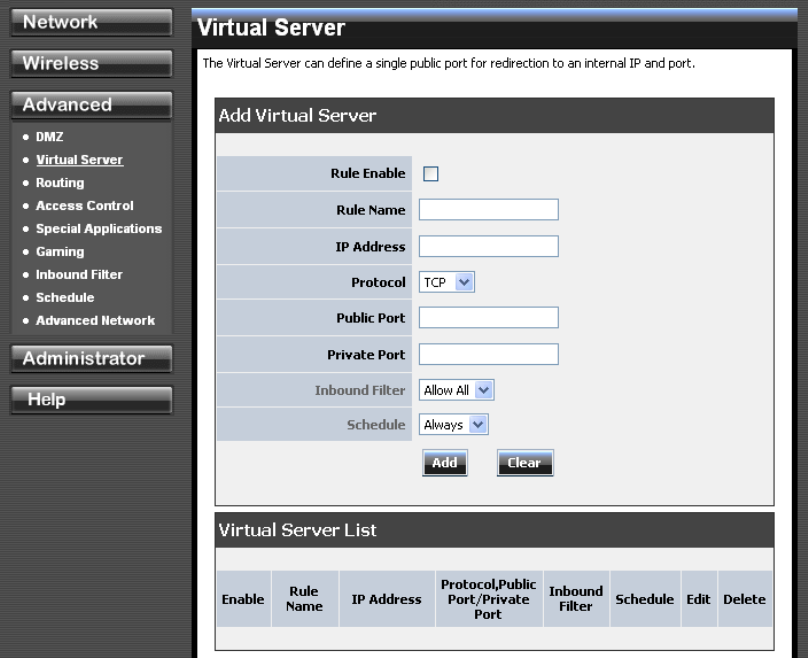
33
4.3.2 Advanced: Virtual Server
Enable
Specifies whether the entry will be active or inactive.
Name
Assign a meaningful name to the virtual server, for example Web Server. Several well-known
types of virtual server are available from the "Application Name" drop-down list. Selecting one
of these entries fills some of the remaining parameters with standard values for that type of
server.
IP Address
The IP address of the system on your internal network that will provide the virtual service, for
example 192.168.10.50. You can select a computer from the list of DHCP clients in the
"Computer Name" drop-down menu, or you can manually enter the IP address of the server
computer.
Protocol
Select the protocol used by the service. The common choices -- UDP, TCP, and both UDP and
TCP -- can be selected from the drop-down menu. To specify any other protocol, select "Other"
from the list, then enter the corresponding protocol number (as assigned by the IANA) in the
Protocol box.
Private Port
The port that will be used on your internal network.
Public Port
The port that will be accessed from the Internet.
Schedule
34
Select a schedule for when the service will be enabled. If you do not see the schedule you
need in the list of schedules.
Clear
Re-initialize this area of the screen, discarding any changes you have made.
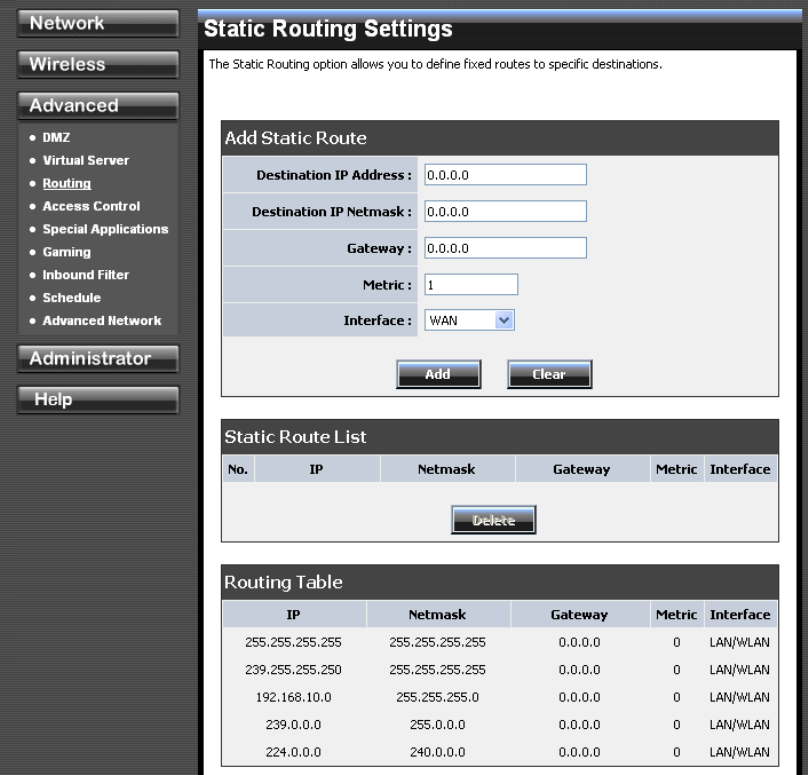
35
4.3.3 Advanced: Routing
Add/Edit Route
Adds a new route to the IP routing table or edits an existing route.
Destination IP
The IP address of packets that will take this route.
Gateway
Specifies the next hop to be taken if this route is used. A gateway of 0.0.0.0 implies there is no
next hop, and the IP address matched is directly connected to the router on the interface
specified: LAN or WAN.
Metric
The route metric is a value from 1 to 16 that indicates the cost of using this route. A value of 1
is the lowest cost, and 15 is the highest cost. A value of 16 indicates that the route is not
reachable from this router. When trying to reach a particular destination, computers on your
network will select the best route, ignoring unreachable routes.
Interface
Specifies the interface -- LAN or WAN -- that the IP packet must use to transit out of the router,
when this route is used.
36
Clear
Re-initialize this area of the screen, discarding any changes you have made.
Routes List
The section shows the current routing table entries. Certain required routes are predefined and
cannot be changed. Routes that you add can be changed by clicking the Edit icon or can be
deleted by clicking the Delete icon. When you click the Edit icon, the item is highlighted, and
the "Edit Route" section is activated for editing. Click the Enable checkbox at the left to directly
activate or de-activate the entry.
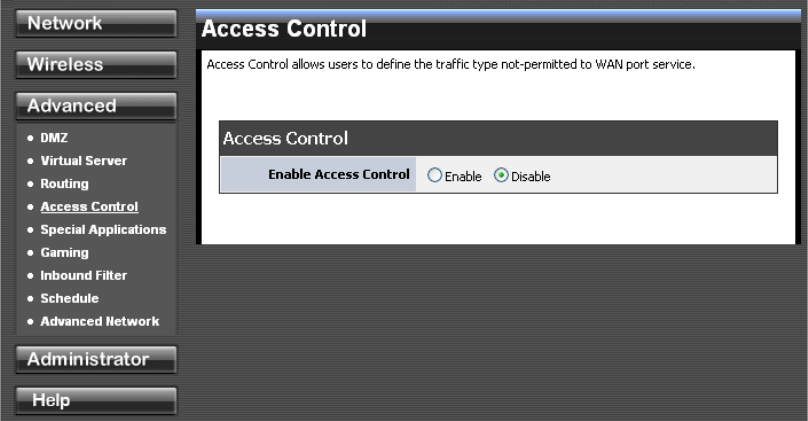
37
4.3.4 Advanced: Access Control
Enable
By default, the Access Control feature is disabled. If you need Access Control, check this
option.
Note: When Access Control is disabled, every device on the LAN has unrestricted access to
the Internet. However, if you enable Access Control, Internet access is restricted for those
devices that have an Access Control Policy configured for them. All other devices have
unrestricted access to the Internet.
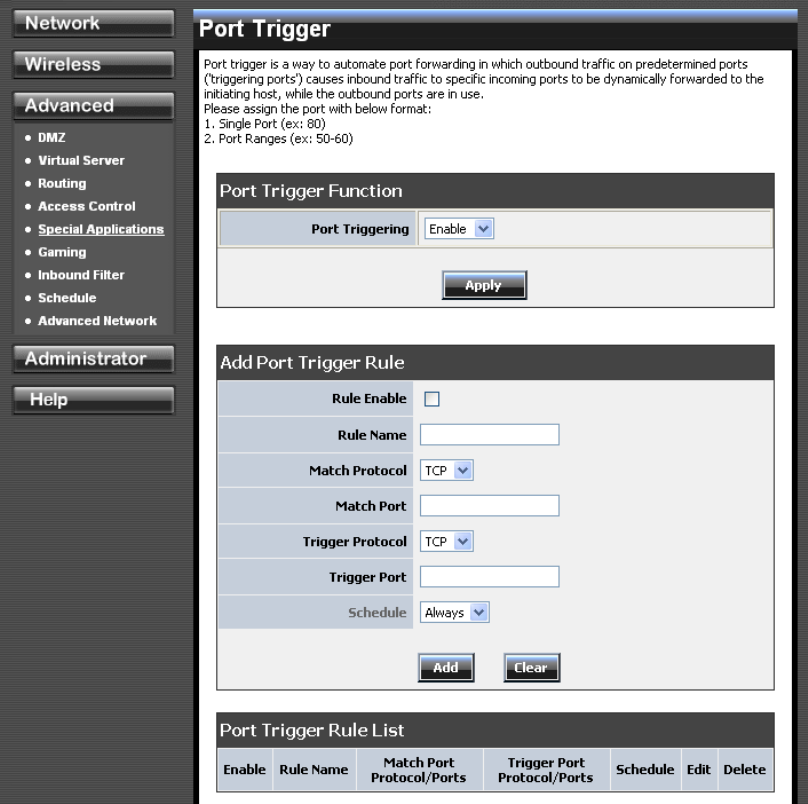
38
4.3.5 Advanced: Special Applications
Add/Edit Port Trigger Rule
Enable
Specifies whether the entry will be active or inactive.
Name
Enter a name for the Special Application Rule, for example Game App, which will help you
identify the rule in the future. Alternatively, you can select from the Application list of common
applications.
Protocol
Select the protocol used by the service. The common choices -- UDP, TCP, and both UDP and
TCP -- can be selected from the drop-down menu.
Trigger Port
Enter the outgoing port range used by your application (for example 6500-6700).
39
Schedule
Select a schedule for when this rule is in effect.
Clear
Re-initialize this area of the screen, discarding any changes you have made.
Port Trigger Rule List
This is a list of the defined application rules. Click the Enable checkbox at the left to directly
activate or de-activate the entry. An entry can be changed by clicking the Edit icon or can be
deleted by clicking the Delete icon.
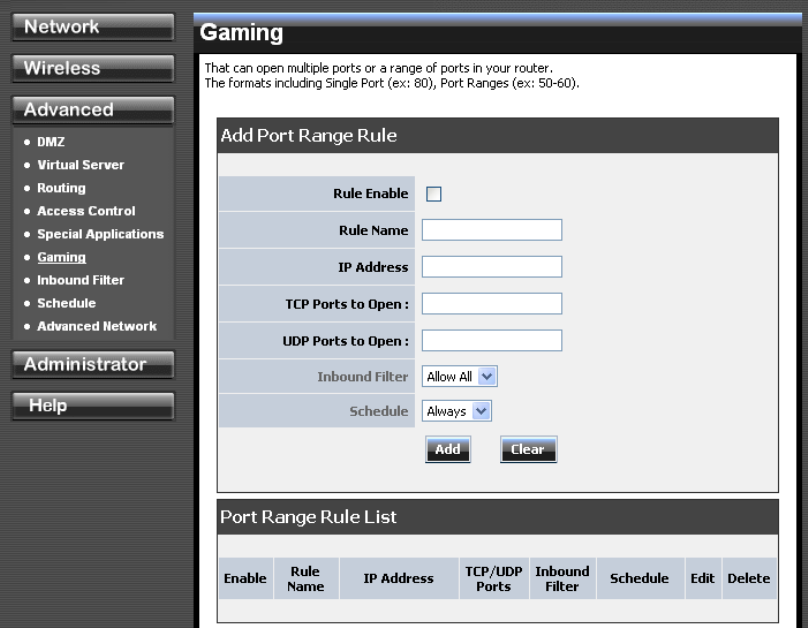
40
4.3.6 Advanced: Gaming
Add/Edit Port Range Rule
Use this section to add a Port Range Rule to the following list or to edit a rule already in the
list.
Rule Enable
Specifies whether the entry will be active or inactive.
Rule Name
Give the rule a name that is meaningful to you, for example Game Server. You can also select
from a list of popular games, and many of the remaining configuration values will be filled in
accordingly. However, you should check whether the port values have changed since this list
was created, and you must fill in the IP address field.
IP Address
Enter the local network IP address of the system hosting the server, for example
192.168.10.50. You can select a computer from the list of DHCP clients in the "Computer
Name" drop-down menu, or you can manually enter the IP address of the server computer.
TCP Ports to Open
Enter the TCP ports to open (for example 6159-6180, 99).
UDP Ports to Open
Enter the UDP ports to open (for example 6159-6180, 99).
Inbound Filter
Select a filter that controls access as needed for this rule.
41
Schedule
Select a schedule for the times when this rule is in effect.
Clear
Re-initialize this area of the screen, discarding any changes you have made.
Port Range Rule List
This is a list of the defined Port Range Rules. Click the Enable checkbox at the left to directly
activate or de-activate the entry. An entry can be changed by clicking the Edit icon or can be
deleted by clicking the Delete icon. When you click the Edit icon, the item is highlighted, and
the "Edit Port Forwarding Rule" section is activated for editing.
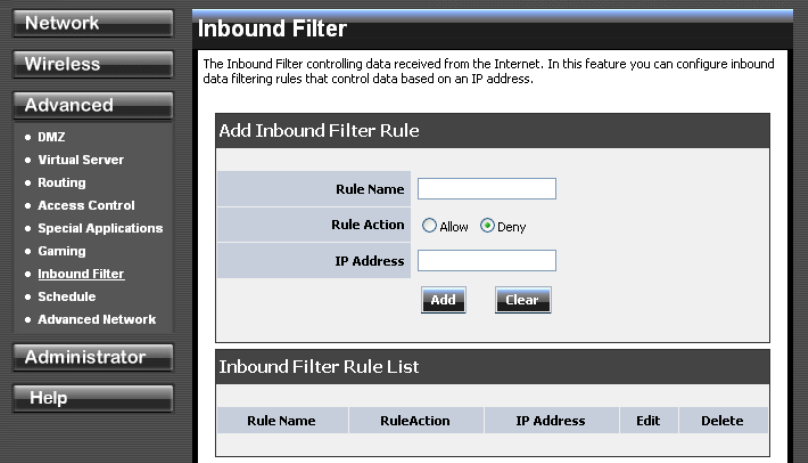
42
4.3.7 Advanced: Inbound Filter
Add/Edit Inbound Filter Rule
Here you can add entries to the Inbound Filter Rules List below, or edit existing entries.
Name
Enter a name for the rule that is meaningful to you.
Action
The rule can either Allow or Deny messages.
Remote IP Range
Define the ranges of Internet addresses this rule applies to. For a single IP address, enter the
same address in both the Start and End boxes. Up to eight ranges can be entered. The
Enable checkbox allows you to turn on or off specific entries in the list of ranges.
Clear
Re-initialize this area of the screen, discarding any changes you have made.
Inbound Filter Rules List
The section lists the current Inbound Filter Rules. An entry can be changed by clicking the Edit
icon or can be deleted by clicking the Delete icon. When you click the Edit icon, the item is
highlighted, and the "Edit Inbound Filter Rule" section is activated for editing.
In addition to the filters listed here, two predefined filters are available wherever inbound filters
can be applied:
Allow All
Permit any WAN user to access the related capability.
Deny All
Prevent all WAN users from accessing the related capability. (LAN users are not affected by
Inbound Filter Rules.)
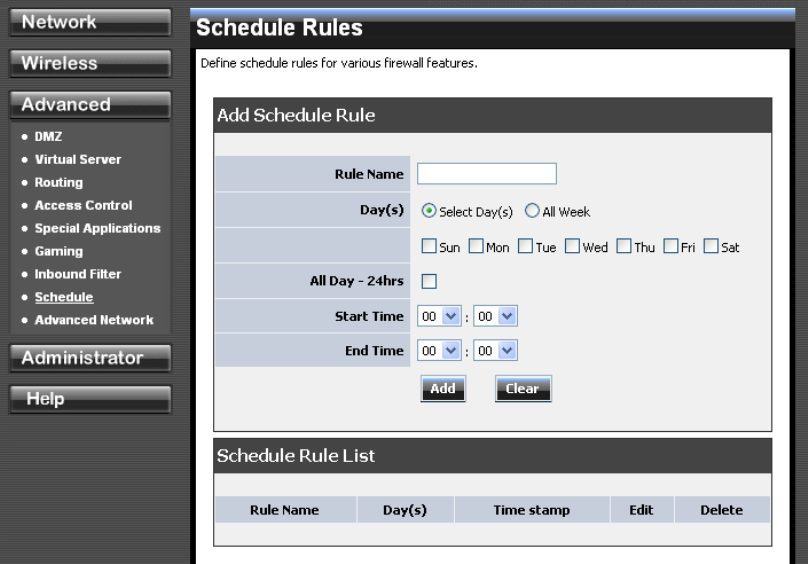
43
4.3.8 Advanced: Schedule
Add/Edit Schedule Rule
In this section you can add entries to the Schedule Rules List below or edit existing entries.
Name
Give the schedule a name that is meaningful to you, such as "Weekday rule".
Day(s)
Place a checkmark in the boxes for the desired days or select the All Week radio button to
select all seven days of the week.
All Day - 24 hrs
Select this option if you want this schedule in effect all day for the selected day(s).
Start Time
If you don't use the All Day option, then you enter the time here. The start time is entered in
two fields. The first box is for the hour and the second box is for the minute. Email events are
normally triggered only by the start time. End Time
The end time is entered in the same format as the start time. The hour in the first box and the
minutes in the second box. The end time is used for most other rules, but is not normally used
for email events.
Clear
Re-initialize this area of the screen, discarding any changes you have made.
Schedule Rules List
This section shows the currently defined Schedule Rules. An entry can be changed by clicking
the Edit icon or can be deleted by clicking the Delete icon. When you click the Edit icon, the
item is highlighted, and the "Edit Schedule Rule" section is activated for editing.
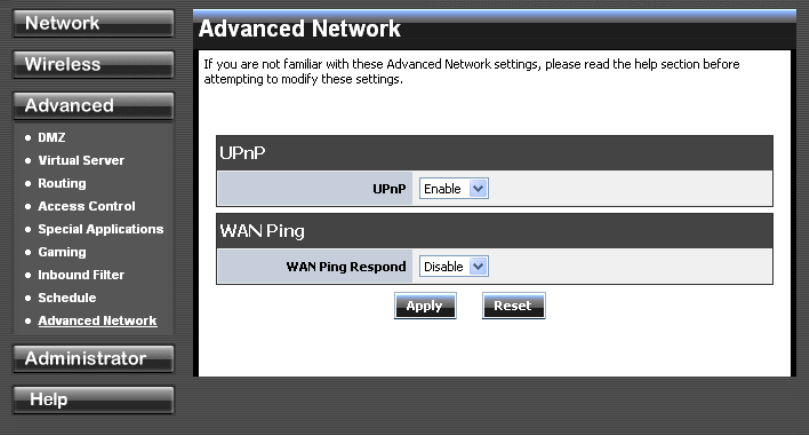
44
4.3.9 Advanced: Advanced Network
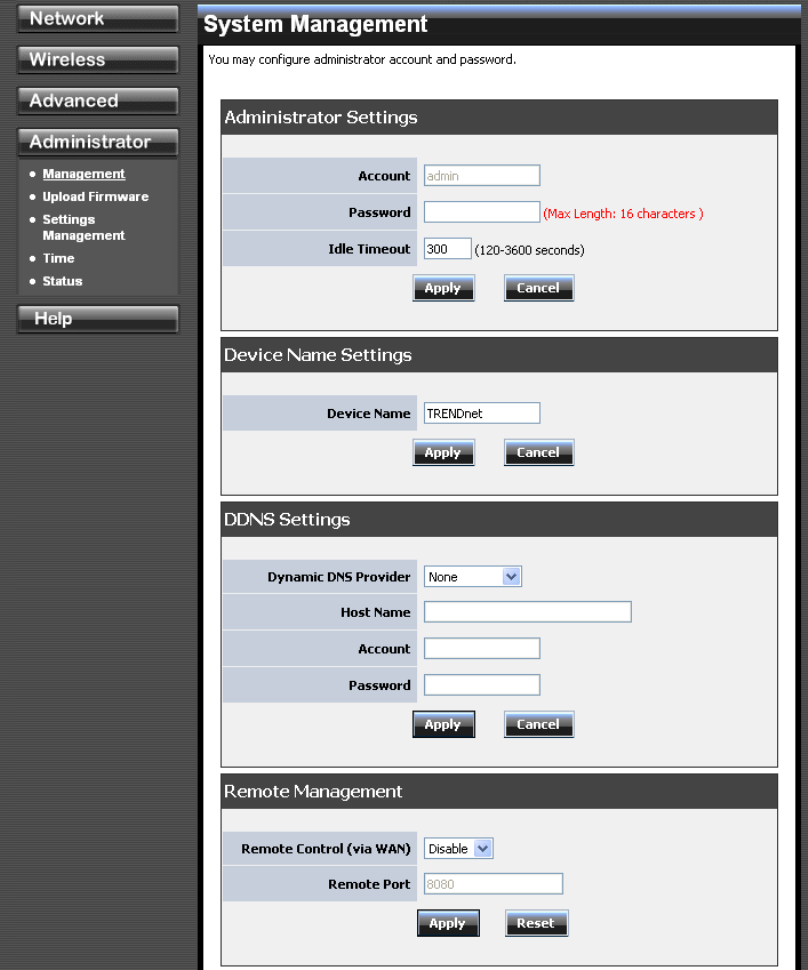
45
Administrator
4.4.1 Administrator: Management
Admin Password
Enter a password for the user "admin", who will have full access to the Web-based
management interface.
Device Name
The name of the router can be changed here.
Enable Dynamic DNS
46
Enable this option only if you have purchased your own domain name and registered with a
dynamic DNS service provider. The following parameters are displayed when the option is
enabled.
Dynamic DNS Provider
Select a dynamic DNS service provider from the pull-down list.
Host Name
Enter your host name, fully qualified; for example: myhost.mydomain.net.
Account
Enter the account provided by your service provider. If the Dynamic DNS provider supplies
only a key, enter that key in all three fields.
Password
Enter the password provided by your service provider. If the Dynamic DNS provider supplies
only a key, enter that key in all three fields.
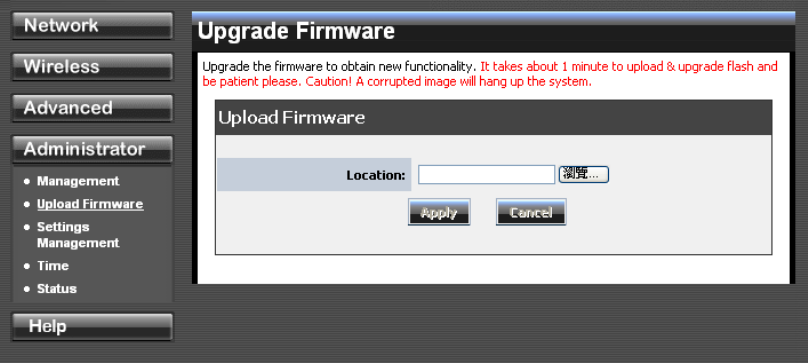
47
4.4.2 Administrator: Upload Firmware
Once you have a firmware update on your computer, use this option to browse for the file and then
upload the information into the router.
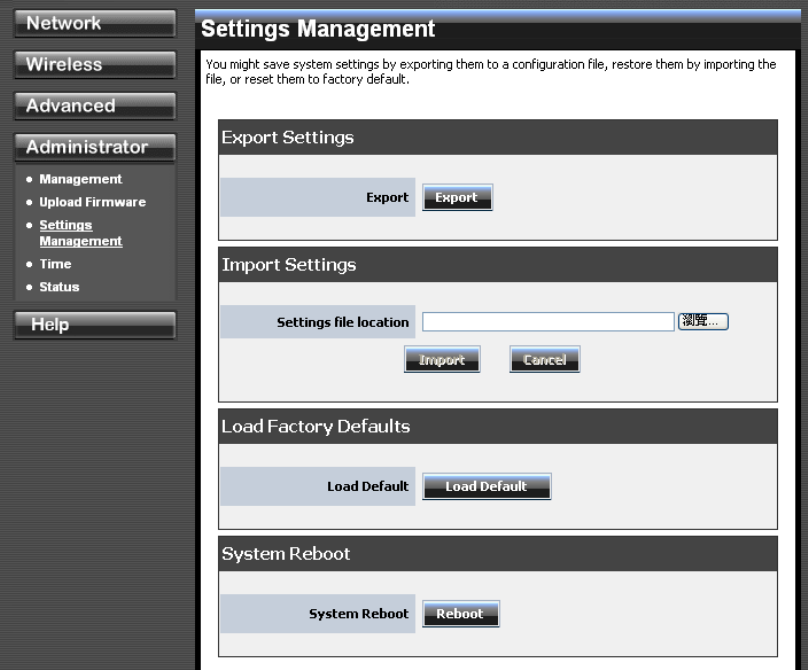
48
4.4.3 Administrator: Setting Management
Export Settings
This option allows you to export and then save the router's configuration to a file on your
computer. Be sure to save the configuration before performing a firmware upgrade.
Import Settings
Use this option to restore previously saved router configuration settings.
Load Factory Defaults
This option restores all configuration settings back to the settings that were in effect at the time
the router was shipped from the factory. Any settings that have not been saved will be lost. If
you want to save your router configuration settings, use the Export Settings option above.
System Reboot
This restarts the router. It is useful for restarting when you are not near the device.
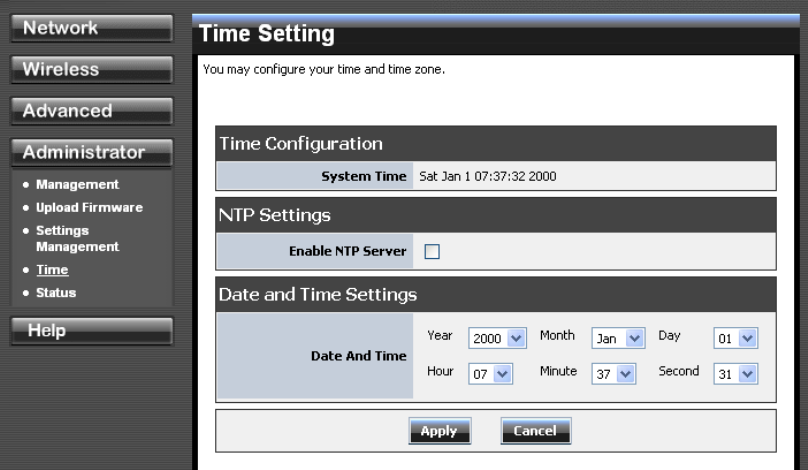
49
4.4.4 Administrator: Time
Time Configuration
Current Router Time
Displays the time currently maintained by the router. If this is not correct, use the following
options to configure the time correctly.
Time Zone
Select your local time zone from pull down menu.
Automatic Time Configuration
Enable NTP Server
Select this option if you want to synchronize the router's clock to a Network Time Server over
the Internet. If you are using schedules or logs, this is the best way to ensure that the
schedules and logs are kept accurate. Note that, even when NTP Server is enabled, you must
still choose a time zone and set the daylight saving parameters.
NTP Server Used
Select a Network Time Server for synchronization. You can type in the address of a time
server or select one from the list. If you have trouble using one server, select another.
Set the Date and Time Manually
If you do not have the NTP Server option in effect, you can either manually set the time for
your router here.
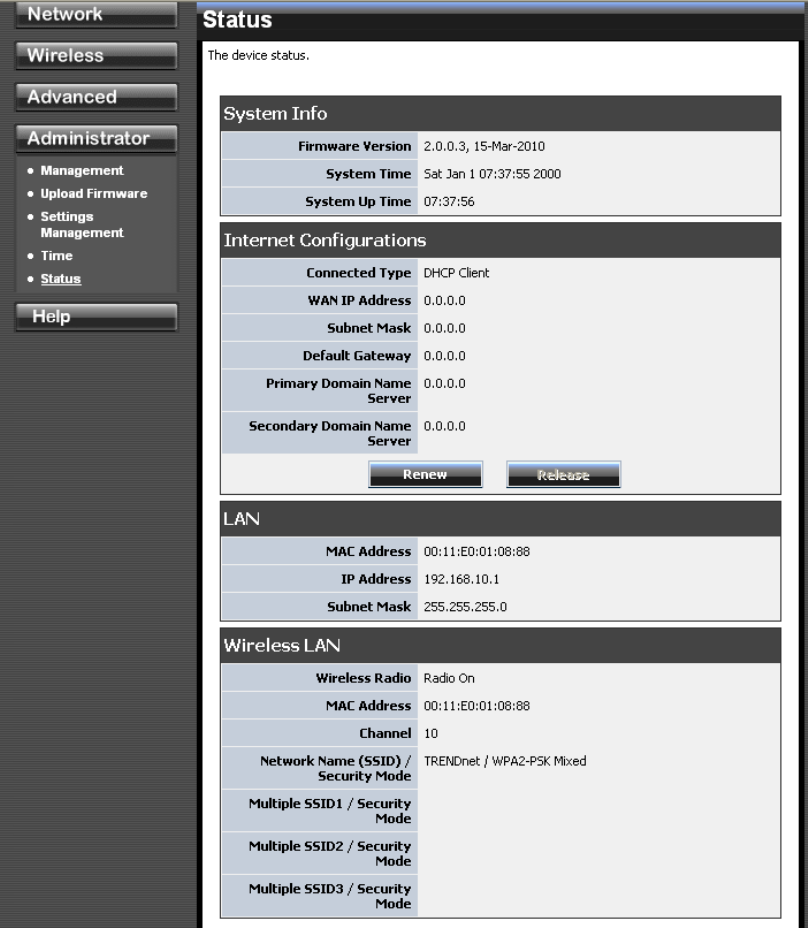
50
4.4.5 Administrator: Status
The device status.
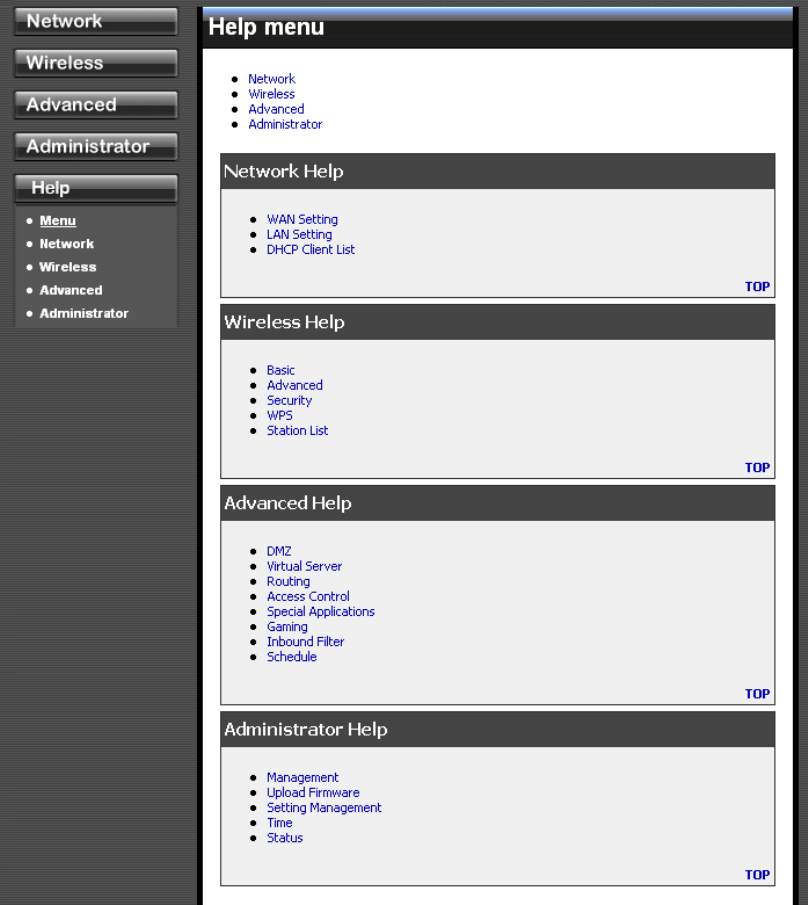
51
4.4 Help
Help section provides web-based explanations on each configurable field.
52
Network Glossary
Access Point - A device that allows wireless-equipped computers and other devices to communicate with a wired network.
also used to expand the range of a wireless network.
AES (Advanced Encryption Standard) - A security method that uses symmetric 128-bit block data encryption.
Bandwidth - The transmission capacity of a given device or network.
Bit - A binary digit.
Boot - To start a device and cause it to start executing instructions.
Broadband - An always-on, fast Internet connection.
Browser - An application program that provides a way to look at and interact with all the information on the World Wide
Web.
Cable Modem - A device that connects a computer to the cable television network, which in turn connects to the Internet.
Daisy Chain - A method used to connect devices in a series, one after the other.
DDNS (Dynamic Domain Name System) - Allows the hosting of a website, FTP server, or e-mail server with a fixed
domain name (e.g., www.xyz.com) and a dynamic IP address.
Default Gateway - A device that forwards Internet traffic from your local area network.
DHCP (Dynamic Host Configuration Protocol) - A networking protocol that allows administrators to assign temporary IP
addresses to network computers by “leasing” an IP address to a user for a limited amount of time, instead of assigning
permanent IP addresses.
DMZ (Demilitarized Zone) - Removes the Router's firewall protection from one PC, allowing it to be “seen” from the
Internet.
DNS (Domain Name Server) - The IP address of your ISP's server, which translates the names of websites into IP addresses.
Domain - A specific name for a network of computers.
Download - To receive a file transmitted over a network.
DSL (Digital Subscriber Line) - An always-on broadband connection over traditional phone lines.
Dynamic IP Address - A temporary IP address assigned by a DHCP server.
EAP (Extensible Authentication Protocol) - A general authentication protocol used to control network access.
Many specific authentication methods work within this framework.
Encryption - Encoding data transmitted in a network.
Ethernet - IEEE standard network protocol that specifies how data is placed on and retrieved from a common transmission
medium.
Firewall - A set of related programs located at a network gateway server that protects the resources of a network from users
from other networks.
Firmware - The programming code that runs a networking device.
FTP (File Transfer Protocol) - A protocol used to transfer files over a TCP/IP network.
53
Full Duplex - The ability of a networking device to receive and transmit data simultaneously.
Gateway - A device that interconnects networks with different, incompatible communications protocols.
Half Duplex - Data transmission that can occur in two directions over a single line, but only one direction at a time.
HTTP (HyperText Transport Protocol) - The communications protocol used to connect to servers on the World Wide Web.
Infrastructure - A wireless network that is bridged to a wired network via an access point.
IP (Internet Protocol) - A protocol used to send data over a network
IP Address - The address used to identify a computer or device on a network.
IPCONFIG - A Windows 2000 and XP utility that displays the IP address for a particular networking device.
IPSec (Internet Protocol Security) - A VPN protocol used to implement secure exchange of packets at the IP layer.
ISP (Internet Service Provider) - A company that provides access to the Internet.
LAN - The computers and networking products that make up your local network.
MAC (Media Access Control) Address - The unique address that a manufacturer assigns to each networking device.
Mbps (MegaBits Per Second) - One million bits per second; a unit of measurement for data transmission.
NAT (Network Address Translation) - NAT technology translates IP addresses of a local area network to a different IP
address for the Internet.
Packet - A unit of data sent over a network.
Passphrase - Used much like a password, a passphrase simplifies the WEP encryption process by automatically generating
the WEP encryption keys for Linksys products.
Ping (Packet Internet Groper) - An Internet utility used to determine whether a particular IP address is online.
POP3 (Post Office Protocol 3) - A standard mail server commonly used on the Internet.
Port - The connection point on a computer or networking device used for plugging in cables or adapters.
Power over Ethernet (PoE) - A technology enabling an Ethernet network cable to deliver both data and power.
PPPoE (Point to Point Protocol over Ethernet) - A type of broadband connection that provides authentication
(username and password) in addition to data transport.
PPTP (Point-to-Point Tunneling Protocol) - A VPN protocol that allows the Point to Point Protocol (PPP) to be tunneled
through an IP network. This protocol is also used as a type of broadband connection in Europe.
RADIUS (Remote Authentication Dial-In User Service) - A protocol that uses an authentication server to control network
access.
RJ-45 (Registered Jack-45) - An Ethernet connector that holds up to eight wires.
Roaming - The ability to take a wireless device from one access point's range to another without losing the connection.
Router - A networking device that connects multiple networks together.
Server - Any computer whose function in a network is to provide user access to files, printing, communications, and other
services.
54
SMTP (Simple Mail Transfer Protocol) - The standard e-mail protocol on the Internet.
SNMP (Simple Network Management Protocol) - A widely used network monitoring and control protocol.
SPI (Stateful Packet Inspection) Firewall - A technology that inspects incoming packets of information before allowing
them to enter the network.
SSID (Service Set IDentifier) - Wireless network's name.
Static IP Address - A fixed assigned address to a computer or device that is connected to a network.
Static Routing - Forwarding data in a network via a fixed path.
Subnet Mask - An address code that determines the size of the network.
Switch - 1. A data switch that connects computing devices to host computers, allowing a large number of devices to share a
limited number of ports. 2. A device for making, breaking, or changing the connections in an electrical circuit.
TCP (Transmission Control Protocol) - A network protocol for transmitting data that requires acknowledgement from the
recipient of data sent.
TCP/IP (Transmission Control Protocol/Internet Protocol) - A set of instructions PCs use to communicate over a network.
Telnet - A user command and TCP/IP protocol used for accessing remote PCs.
TFTP (Trivial File Transfer Protocol) - A version of the TCP/IP FTP protocol that has no directory or password capability.
Throughput - The amount of data moved successfully from one node to another in a given time period.
TKIP (Temporal Key Integrity Protocol) - a wireless encryption protocol that provides dynamic encryption keys for each
packet transmitted.
Topology - The physical layout of a network.
TX Rate - Transmission Rate.
Upgrade - To replace existing software or firmware with a newer version.
Upload - To transmit a file over a network.
URL (Uniform Resource Locator) - The address of a file located on the Internet.
VPN (Virtual Private Network) - A security measure to protect data as it leaves one network and goes to another over the
Internet.
WAN (Wide Area Network)- The Internet.
WEP (Wired Equivalent Privacy) - A method of encrypting network data transmitted on a wireless network for
greater security.
WLAN (Wireless Local Area Network) - A group of computers and associated devices that communicate with each other
wirelessly.
WPA (Wi-Fi Protected Access) - a wireless security protocol using TKIP (Temporal Key Integrity Protocol) encryption,
which can be used in conjunction with a RADIUS server.

55
Limited Warranty
TRENDnet warrants its products against defects in material and workmanship, under normal
use and service, for the following lengths of time from the date of purchase.
TEW-691GR 3 years
If a product does not operate as warranted above during the applicable warranty period,
TRENDnet shall, at its option and expense, repair the defective product or deliver to customer
an equivalent product to replace the defective item. All products that are replaced will
become the property of TRENDnet. Replacement products may be new or reconditioned.
TRENDnet shall not be responsible for any software, firmware, information, or memory data of
customer contained in, stored on, or integrated with any products returned to TRENDnet
pursuant to any warranty.
There are no user serviceable parts inside the product. Do not remove or attempt to service
the product through any unauthorized service center. This warranty is voided if (i) the
product has been modified or repaired by any unauthorized service center, (ii) the product
was subject to accident, abuse, or improper use (iii) the product was subject to conditions
more severe than those specified in the manual.
Warranty service may be obtained by contacting TRENDnet office within the applicable
warranty period for a Return Material Authorization (RMA) number, accompanied by a copy of
the dated proof of the purchase. Products returned to TRENDnet must be pre-authorized by
TRENDnet with RMA number marked on the outside of the package, and sent prepaid,
insured and packaged appropriately for safe shipment.
WARRANTIES EXCLUSIVE: IF THE TRENDNET PRODUCT DOES NOT OPERATE AS
WARRANTED ABOVE, THE CUSTOMER’S SOLE REMEDY SHALL BE, AT TRENDNET’S
OPTION, REPAIR OR REPLACEMENT. THE FOREGOING WARRANTIES AND REMEDIES
ARE EXCLUSIVE AND ARE IN LIEU OF ALL OTHER WARRANTIES, EXPRESSED OR
IMPLIED, EITHER IN FACT OR BY OPERATION OF LAW, STATUTORY OR OTHERWISE,
INCLUDING WARRANTIES OF MERCHANTABILITY AND FITNESS FOR A PARTICULAR
PURPOSE. TRENDNET NEITHER ASSUMES NOR AUTHORIZES ANY OTHER PERSON
TO ASSUME FOR IT ANY OTHER LIABILITY IN CONNECTION WITH THE SALE,
INSTALLATION, MAINTENANCE OR USE OF TRENDNET’S PRODUCTS.
TRENDNET SHALL NOT BE LIABLE UNDER THIS WARRANTY IF ITS TESTING AND
EXAMINATION DISCLOSE THAT THE ALLEGED DEFECT IN THE PRODUCT DOES NOT
EXIST OR WAS CAUSED BY CUSTOMER’S OR ANY THIRD PERSON’S MISUSE,
NEGLECT, IMPROPER INSTALLATION OR TESTING, UNAUTHORIZED ATTEMPTS TO
REPAIR OR MODIFY, OR ANY OTHER CAUSE BEYOND THE RANGE OF THE INTENDED
USE, OR BY ACCIDENT, FIRE, LIGHTNING, OR OTHER HAZARD.
LIMITATION OF LIABILITY: TO THE FULL EXTENT ALLOWED BY LAW TRENDNET ALSO
EXCLUDES FOR ITSELF AND ITS SUPPLIERS ANY LIABILITY, WHETHER BASED IN
CONTRACT OR TORT (INCLUDING NEGLIGENCE), FOR INCIDENTAL, CONSEQUENTIAL,

56
INDIRECT, SPECIAL, OR PUNITIVE DAMAGES OF ANY KIND, OR FOR LOSS OF
REVENUE OR PROFITS, LOSS OF BUSINESS, LOSS OF INFORMATION OR DATE, OR
OTHER FINANCIAL LOSS ARISING OUT OF OR IN CONNECTION WITH THE SALE,
INSTALLATION, MAINTENANCE, USE, PERFORMANCE, FAILURE, OR INTERRUPTION
OF THE POSSIBILITY OF SUCH DAMAGES, AND LIMITS ITS LIABILITY TO REPAIR,
REPLACEMENT, OR REFUND OF THE PURCHASE PRICE PAID, AT TRENDNET’S
OPTION. THIS DISCLAIMER OF LIABILITY FOR DAMAGES WILL NOT BE AFFECTED IF
ANY REMEDY PROVIDED HEREIN SHALL FAIL OF ITS ESSENTIAL PURPOSE.
Governing Law: This Limited Warranty shall be governed by the laws of the state of California.
Note: AC/DC Power Adapter, Cooling Fan, Cables and Power Supply carry 1-Year Warranty
Some TRENDnet products include software code written by third party developers. These
codes are subject to the GNU General Public License ("GPL") or GNU Lesser General Public
License ("LGPL").
Go to http://www.trendnet.com/gpl or http://www.trendnet.com Download section and look for
the desired TRENDnet product to access to the GPL Code or LGPL Code. These codes are
distributed WITHOUT WARRANTY and are subject to the copyrights of the developers.
TRENDnet does not provide technical support for these codes. Please go to
http://www.gnu.org/licenses/gpl.txt or http://www.gnu.org/licenses/lgpl.txt for specific terms of each
license.